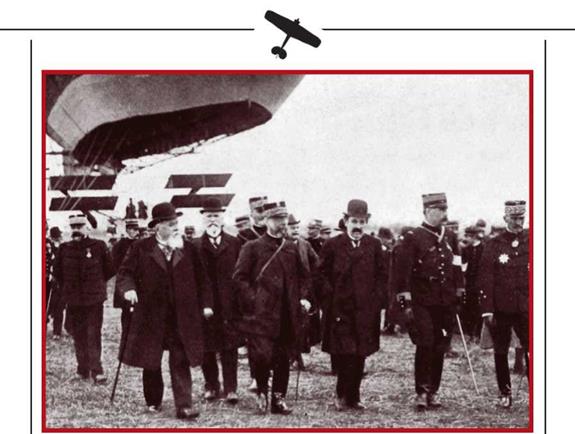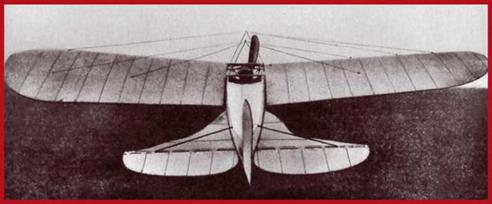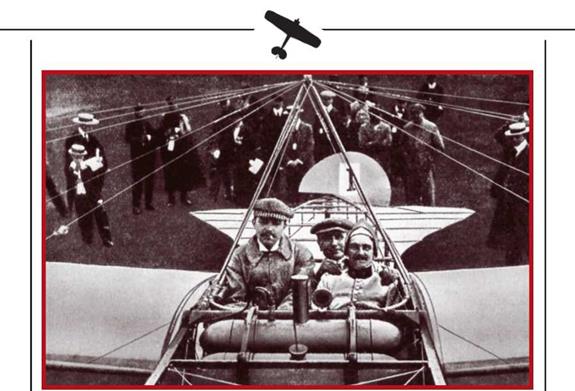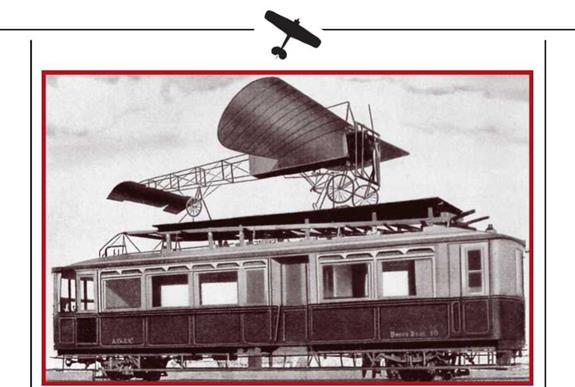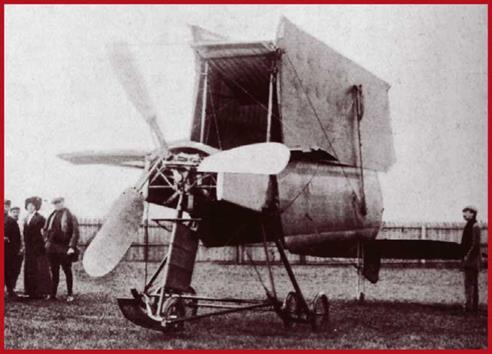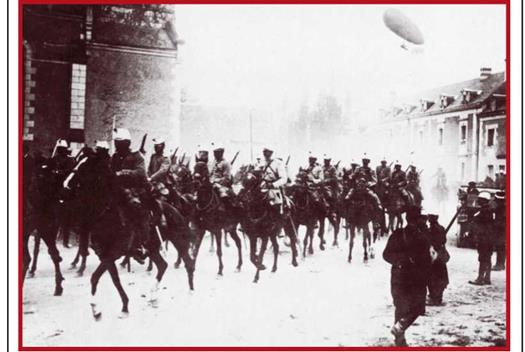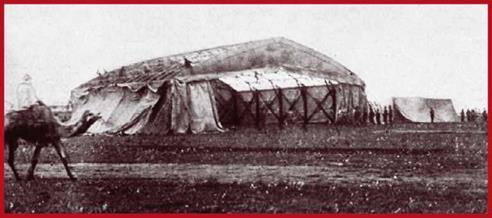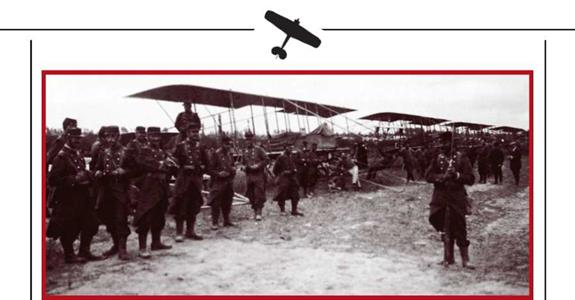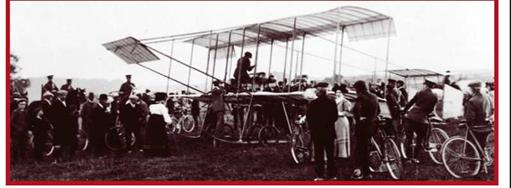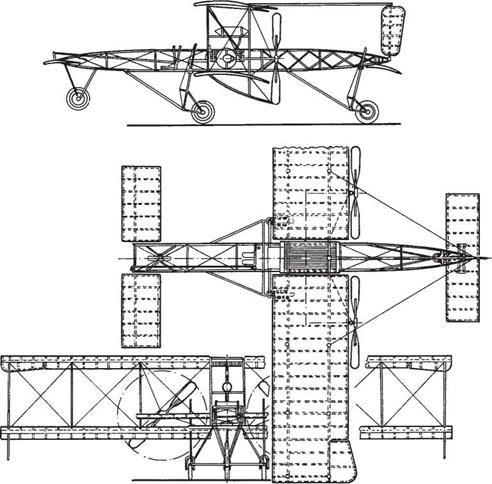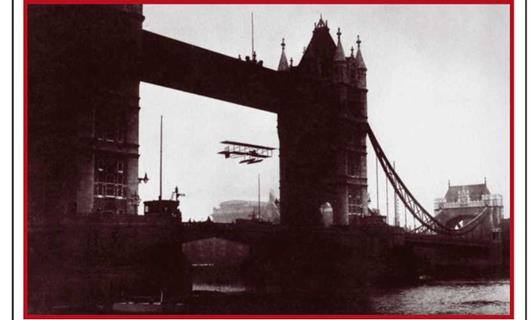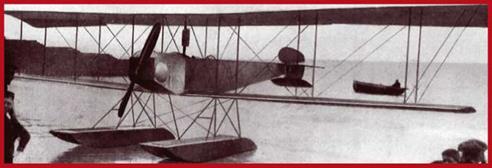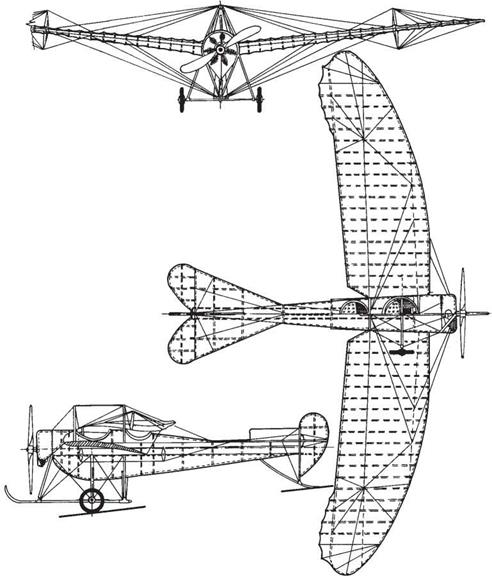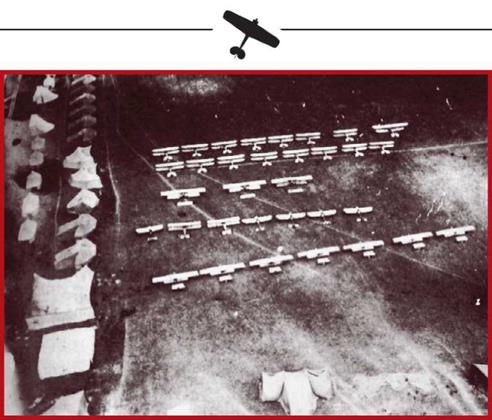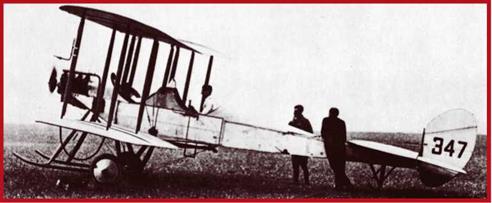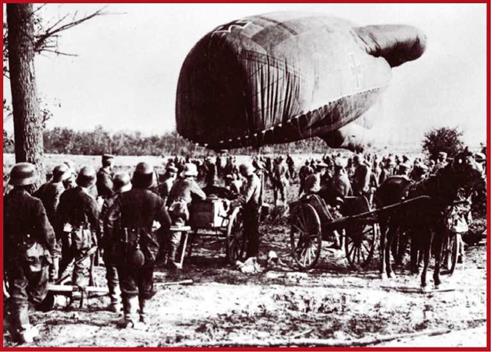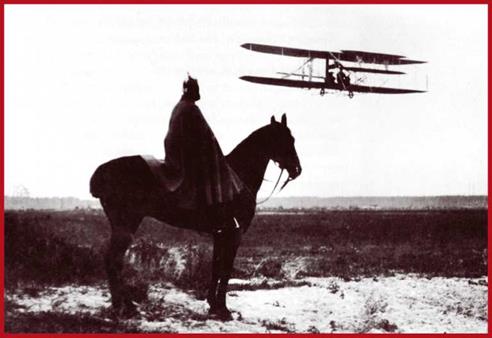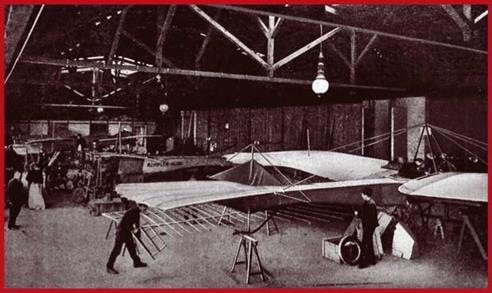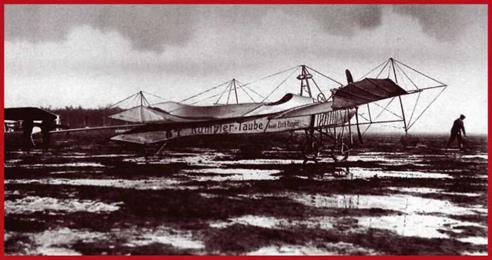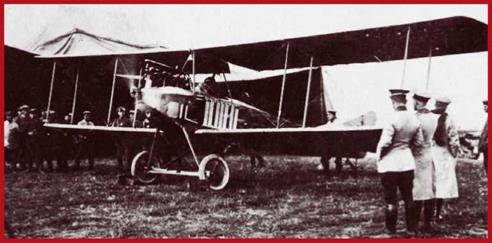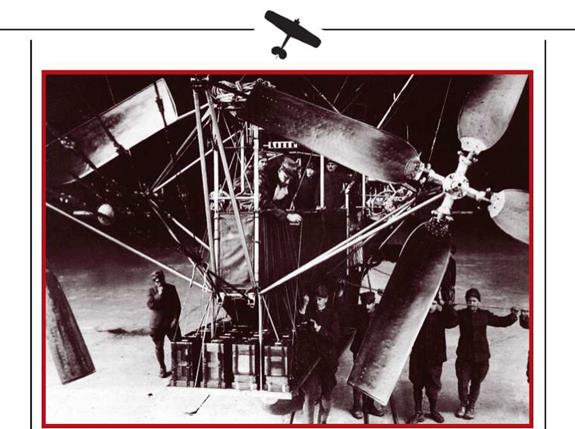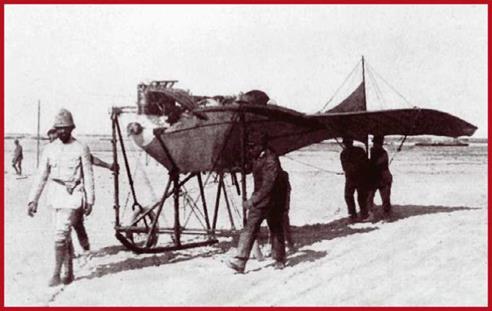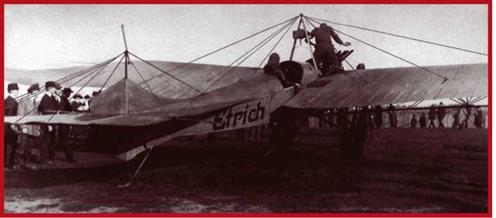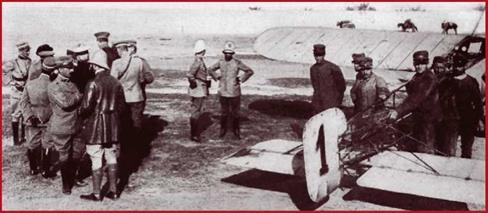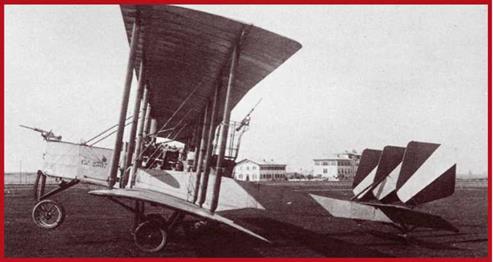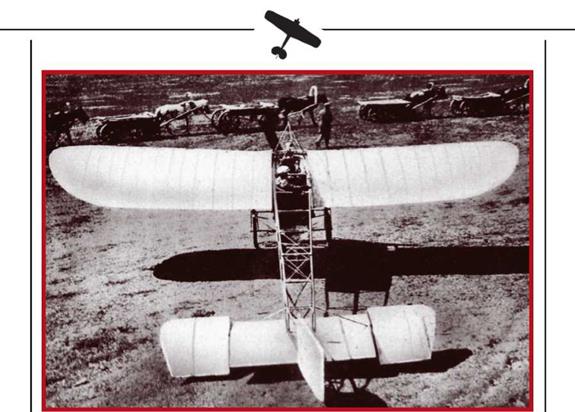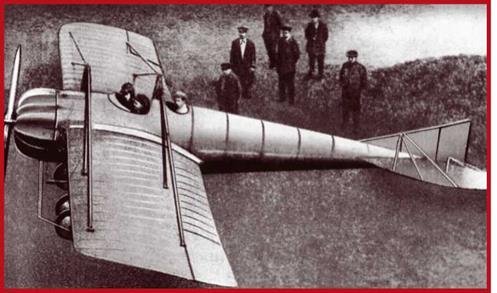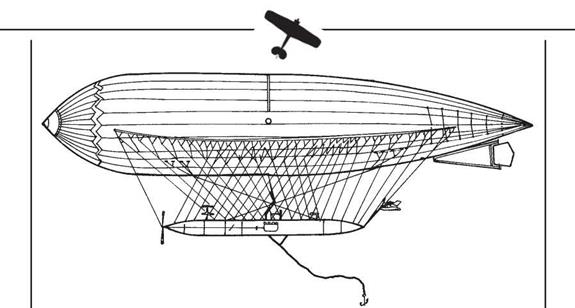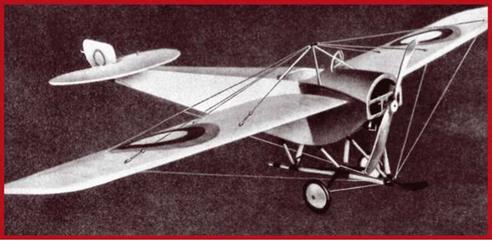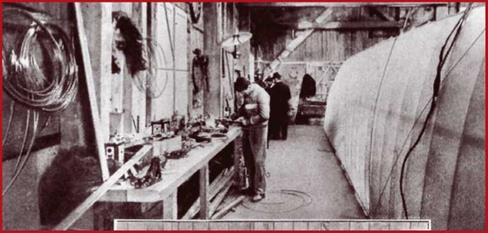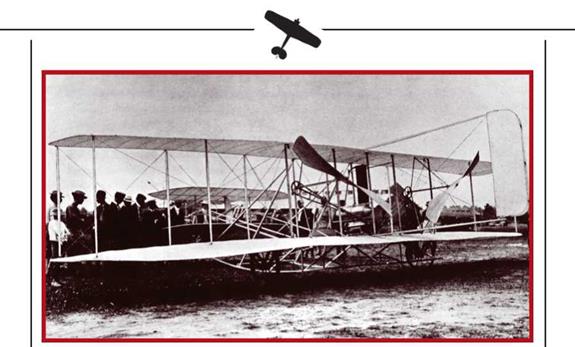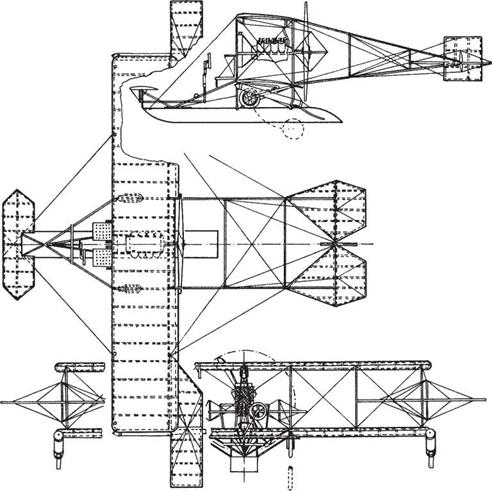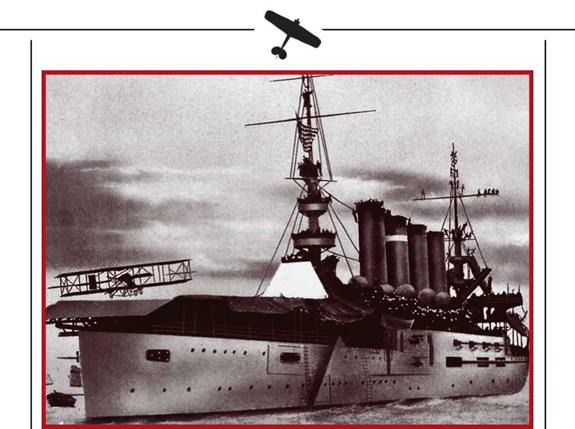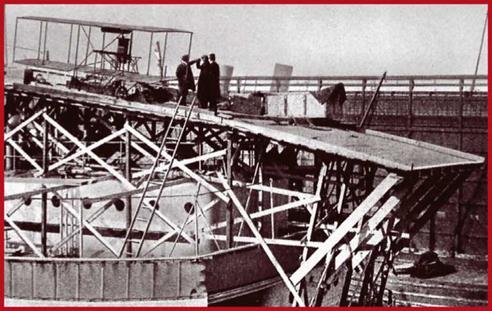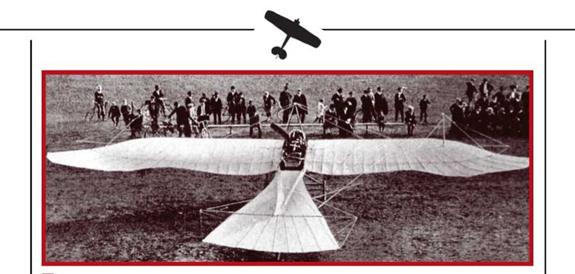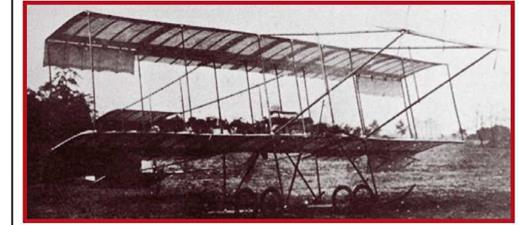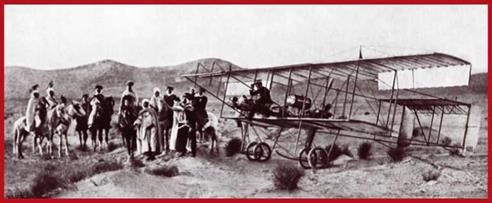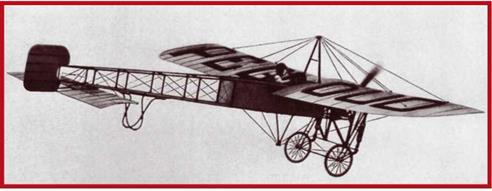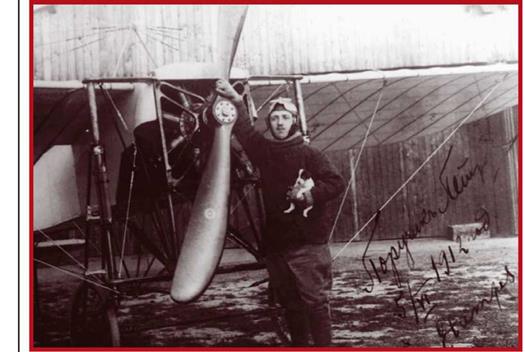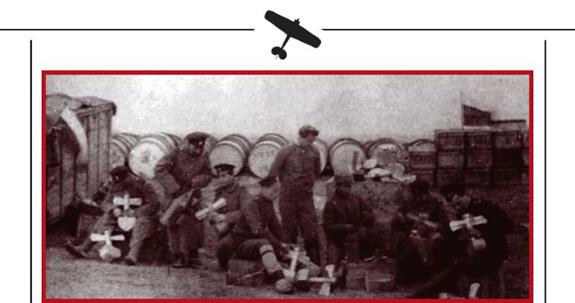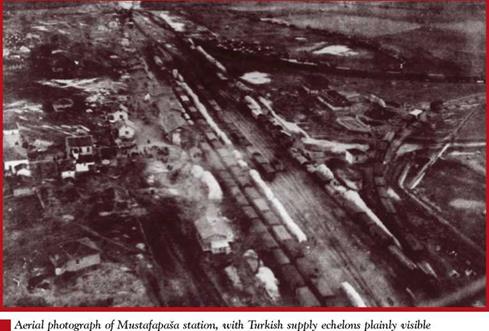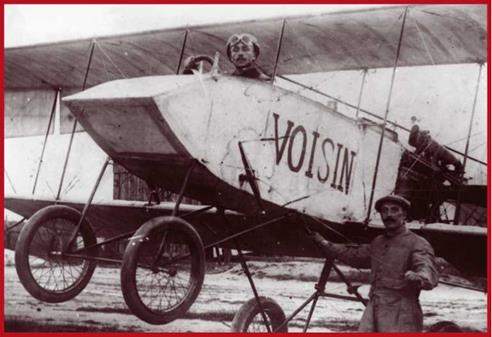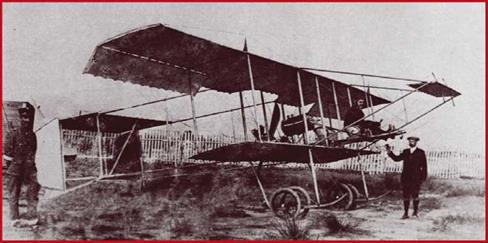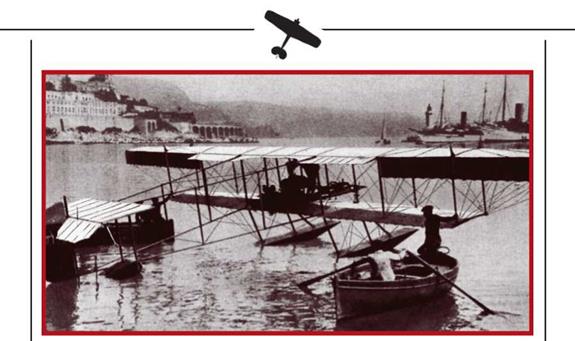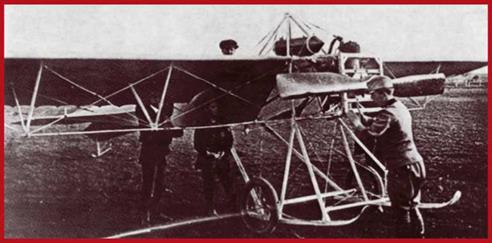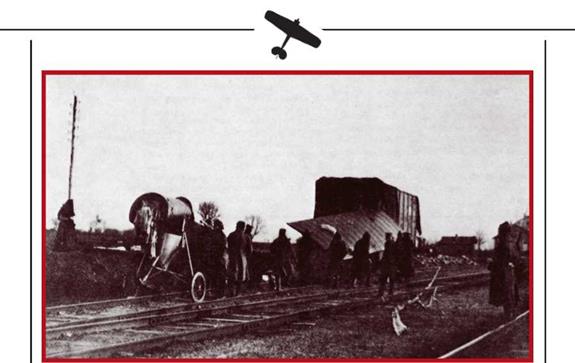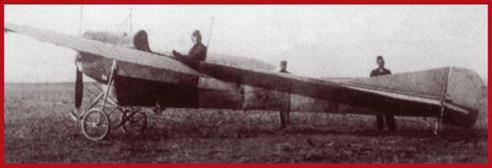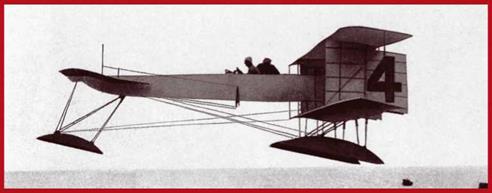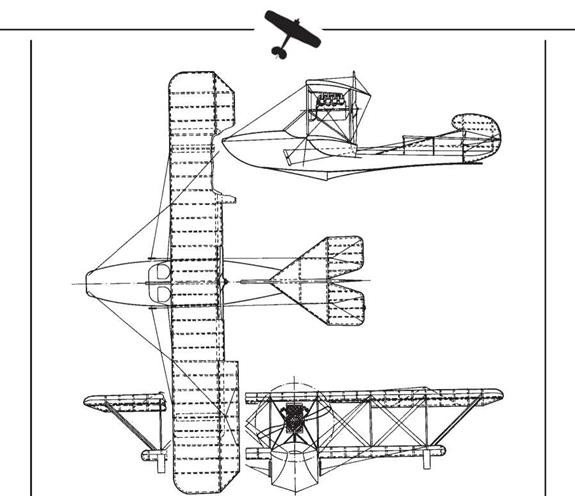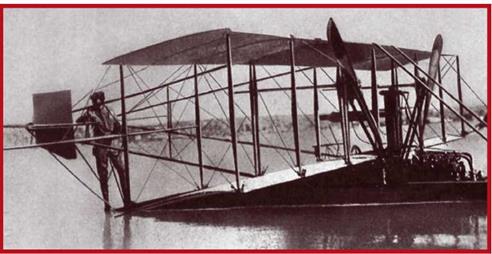EARLY COMBAT UNITS
The creation of stable and reliable flying machines and their spread suggested that the time for air navigation and aviation to be taken seriously by soldiers and statesmen had arrived. And this is indeed what transpired. Production facilities grew apace, especially after the Summer 1911 Agadir Crisis. It became clear to all that a gigantic clash of arms was approaching.
The creation and structuring of air forces as an element of armed power went almost parallel with technical advance. The earliest such units had been established in revolutionary France. Two air navigation units were set up, based upon the Ecole Nationale de Navigation Aerienne, established in 1792. During the defence of Antwerp in 1814, French Aeronaut Carnot used a tethered balloon to observe the enemy. In the Italian War of Independence, another Frenchman, Godard, carried out reconnaissance from a balloon gondola before the Battle of Solferino. The Aerial Bridge organised during 1870 using aerostats allowed the besieged garrison in Paris to maintain links with the outside world.
Employing the modest experience accumulated in war, and the greater background of civilian postal operations, in 1886 France created the Administration Centrale de Navigation Aerienne Militaire. This comprised four newly created and suitably equipped units. Included in Engineering Regiments, they participated in military expeditions in Madagascar in 1894-‘5, China in 1900-‘1, and Morocco in 1908, inter alia. During 1912 the units had ten flying machines of indifferent quality.
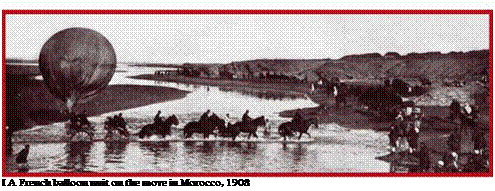 |
Despite failing to accomplish the first flight of a heavier-than-air machine, the Av – ion-3 tests in 1897 attracted the attention of military specialists. Impressed by reports of
what the Flyer-3 could do, in 1905 the French War Ministry sent a delegation to the USA. This had powers to purchase a licence to produce aeroplanes from the Wright brothers. Negotiations ended unsuccessfully for a number of reasons, major among which was the extortionate sum demanded by the inventors. Nevertheless, in 1908 the Wrights did sell a production licence for their machines to the civilian Compagnie Generale de Navigation Aerienne. This was the company through which, on 12 July 1909, the French War Ministry purchased the first aeroplane for the army. The order resulted from the great interest created by Wilbur Wright’s triumphal demonstration of his biplane’s great ability. Regardless of the fact that France’s first aeroplane was American, there was commitment and finance for indigenous designs. The first results of this followed soon: two of Henri Farman’s aeroplanes, a Louis Bleriot monoplane and a Wright biplane were ordered, all being delivered in 1910. The same year the Aeroclub Francaise published the first Regulations for the Awarding of Air Pilots’ Wings.
 |
Aviation entered a period of rapid organisational development. By 1909, French military air navigation and aviation comprised four army balloon units, commanded by Colonel Hirchauer and included within the Engineering Corps. The formation of aeroplane units within these units was commencing, with finance being made available for equipment purchase and crew training. The only French military pilot at the time was Captain Lucas Girardville, who had been trained at the Wright Brothers’ Po school in 1908-‘9. Another ten officers entered training the following year at the Bleriot, Wright, and Farman schools, and at the Antoinette school in Chalonne. First to get his wings was Lieutenant Cammermann, awarded Wings No33 on 7 March 1910. Merely a year later the military began issuing their own wings. The first of these was awarded to Tricarnot de Roz on 7 February 1911. Up until then the War Ministry had earmarked 2500 francs for pilot officer training at private schools.
The first aeroplane was officially commissioned for service on 10 June 1910 after acceptance testing by Captain Eteve. It was a copy of the Wrights’ Flyer-3. The Aviation Exhibition at Rheims did not go unnoticed by French military experts, being followed by orders for Farman and Bleriot. After studying the designs at the exhibition, artillery officers began looking into the possibilities of arming aeroplanes. French War Minister General Brunn made funds available to buy aeroplanes specifically for research purposes. Colonel Estienne was appointed head of the Aviation Inspectorate, and following a parliamentary debate, a Military Aviation Administration was established under Lieutenant Cammermann’s command. Based near Chalonne, this came into service in April 1910 and its organisation was complete by 9 June when the first reconnaissance sortie was flown. At 4:30pm, pilot Lieutenant Frecon and observer Captain Marcone departed the Military Aviation School airfield in their Farman and flew the 145km to Vencan in two and a half hours. Despite various crises on board, they managed to take a variety of intriguing aerial photographs.
The new structure grew more experienced by the day. On 10 August, Captain Manorie, Commander of the elite XX Corps deployed along the border with Germany, requested a reconnaissance flight along the Corps front. The same day another aeroplane directed fire during artillery training near Nancy, and its positive contribution to precision was noted.
 Considering the moment propitious, General Roques, head of the Military Aerial Fleet Inspectorate, and his deputy Hirschauer proposed that aeroplanes and crews be included in the large scale September manoeuvres in Picardy. Examining the good results of the 10 August flights, the Supreme Command granted assent. General Roques prepared for the manoeuvres in earnest. Experienced civillian school pilots, among whom Hubert Latham, Louis Bleriot and Louis Poland, were invited to take part.
Considering the moment propitious, General Roques, head of the Military Aerial Fleet Inspectorate, and his deputy Hirschauer proposed that aeroplanes and crews be included in the large scale September manoeuvres in Picardy. Examining the good results of the 10 August flights, the Supreme Command granted assent. General Roques prepared for the manoeuvres in earnest. Experienced civillian school pilots, among whom Hubert Latham, Louis Bleriot and Louis Poland, were invited to take part.
Despite the very modest number of aeroplanes (two Framans, a Sommer, and a Bleriot in the Second Corps, and two Framans, a Wright, and a Bleriot in the Ninth Corps), results exceeded Ц Hubert Latam prior to the start of military ma – Roques’s, Hirschauer’s and their pilots’ noeuvres in 1910
|
I Left to right: the President of France, General Roques, and Colonel Hirchauer visiting an airfield during the Picardy Manoeuvres |
|
I A two seat military Bleriot |
expectations. The consequences of this brilliant showing in the September manoeuvres were twofold.
First, the purchase of a large number of new aeroplanes was permitted: 20 Bleriots and 20 Farmans. Seventeen of the Bleriots were to be two seaters, enabling observa-
|
A Bleriot military model with seats for pilot, observer and flight engineer |
tion. All 20 were to be delivered over two months. Seven of the Farmans had to accommodate two observers apiece, and the 20 had to be delivered over a three month period. The contracts specified the new machines’ performance: a 60km/h speed, range of up to 300km, and a 300kg payload capability.
Second, the French Senate granted semi-autonomous status to the Military Aviation Administration within the Army. A Resolution of 22 October 1910 transferred General Roques away from the Engineering Corps and promoted him to the rank of General-Inspecteur. He used this favourable circumstance to put into practise two of his ideas which would influence the future of French military aviation greatly. The training of combat pilots came under the military. Roques also gave impetus to the changeover from existing civilian aeroplanes to ones designed specifically for military purposes. By October, the military aviation of the Republique Francaise comprised 20 Farman Ils, six Farman IV, six Sommer-4s, six Voisins, 20 Bleriot IV, four Antoinette-2s, three Nieuports, two Henriots, and two Breguets, inter alia. It had a total of 71 aeroplanes delivered and on order, of which 30 were combat ready. However, no less than 11 types of machine were operated, and this affected operations adversely.
The Flying School commenced work. Three airfields were largely used for combat pilot training. The trend was for each group to use one type of aeroplane. The system involved theoretical and flying exams prior to the awarding of wings. A similar proficiency check was used for pilots who had gained wings at civilian schools and now
wished to make a career as army pilots. In 1910 only 31 pilots gained combat wings from a total of 52 checked. Civil pilots upgrading their skills at private schools could enlist as Engineering Battalion reservists. In this way France created a system for preparing the second major component linked with sufficiently trained flight and ground personnel. These people’s life was now subjected to specific flying duties, fulfilling set army requirements, and carrying out set tasks in the army’s interest.
As mentioned above, an important condition on the road to a fully fledged Air Force is the availability of combat aeroplanes designed for genuine combat conditions and actual combat tasks. The Military Aviation Command decided to give designers and manufacturers ample time to meet these requirements. The first competition for new combat aeroplanes was set for October 1911. Apart from performance, each design was to be assessed on its ability to be easily disassembled and stowed for transportation by road or rail, to use fields overgrown with grass, to carry a pilot and observer plus a mechanic when necessary. Headed by General Roques, the assessment commission included many senior officers and civilian specialists employed by the Military Aviation Command. The British War Ministry also delegated three observers.
The competition’s initial round saw 140 aeroplanes by 43 manufacturers compete. Most of them had been over optimistic: only 31 designs reached the testing stage, nine coming out as finalists. Nieuport won, followed by Breguet and Deper – dussin. The winners received monetary awards and immediate orders for ten Nie – uports, six Breguets and four Deperdussins. Similar orders boosted the process of providing the nascent air arm with all it needed for its newly formed units. The French aircraft industry at the time was sufficiently powerful to assume the role of a component, and figures prove this point best.
During 1911, 135 aeroplanes and 1400 aero engines were produced. The respective figures for 1912 were 1425 and 2217; and for 1913: 1148 aeroplanes, 146 floatplanes and 2440 engines. Propeller production numbered over 30,000. The greater part of this output was for export. Tests of the first machine guns mounted on a Far – man began. Other tests involved air to ground radio telegraph transmissions. These demonstrated an affective range of 30km. This was dictated by the logic of development of ground and airborne equipment which enabled the more eficient use of flying machines. However, it would be premature to speak of a separate Air Force component at this stage: this was still the experimental stage.
The crisis in Franco-German relations caused by the Agadir Crisis of summer 1911 raised the profile of the bipartite French Army manoeuvres of the late summer. Involving the Sixth and Seventh Corps, the exercise aimed to practise cover and defence of the borders in an attack from the East, and providing sufficient time for mobilisation and the deployment of reserves. A 25-aeroplane unit supported the Sixth Corps, with as many pilots. Ten of the latter were civilians specially mobilised for the
|
Transporting a Bleriot aeroplane by rail |
|
Щ A Breguet aeroplane stowed for transportation |
manoeuvres. The unit was commanded by Captain Eteve, Commandant of the Versailles Military Aviation School. The Seventh Corps was commanded by Etampes Military Aviation School Commandant Captain Felix, whose tenure was marked by several fatal accidents at the outset of action.
Crews’ performance over the ‘battlefield’ was assessed highly. The wonderful plan photographs of a camouflaged field artillery battery taken by observer Captain Lebon came in for particular praise. Manoeuvre commanders discussed aerial reconnaissance, observation and artillery direction sorties, concluding that:
– aerial reconnaissance aeroplanes were to be two seaters, and were to be capable of use from improvised aerodromes close to the front line;
– it was desirable to afford armour protection to aeroplanes’ more important parts and assemblies, including the crew;
– where possible, aerial reconnaissance data on the enemy were to be duplicated;
– due to the important nature of data from aerial reconnaissance, it was desirable that crews (especially observers) ought to be aware of army staff modi operandi.
Homogenous units began to be formed: these had permanent establishments and were equipped with aeroplanes of one type only. The process began in 1912, with the formation of the first Escadrille (Squadron). This comprised six aeroplanes, flight and
|
Soft dirigibles accompany mobile cavalry units during the 1912 manoeuvres |
technical personnel, transportation, and hangars. Commanded by a Chef d’Escadrille with the rank of Captain, the unit had an alphanumerical designation which showed the type of equipment used: for instance, Escadrille D6 meant ‘Number six Squadron equipped with Deperdussin aircraft’. By mid 1912, the French Army had five Escadrilles:
– HF1, flying Henri Farmans and based at Chalons;
– MF2, flying Maurice Farmans and based at the Buc Flying School airfield;
– B3, flying Bleriots and based at Pan;
– D4, flying Deperdussins and based at Saint Cyr; and
– MF5, flying Maurice Farmans and based at Saint Cyr.
Another organisational change was the appointment of Colonel Hirchauer as head of French military aviation units. He took up the post in April 1912. General Rocault was appointed Commander of No7 Infantry Division. An order of 29 March 1912 removed the Escadrilles from the Central Army Group and established three Aviation Groups:
– First Group, based near Versailles and commanded by Lieutenant Colonel Butnot;
– Second Group, based near Rheims and commanded by Lieutenant Colonel Breton;
– Third Group, based near Lyon and commanded by Lieutenant Colonel Estienne.
The Groups were independent of each other and each had its own logistic and
other support. Each Group had airfields where its individual units (Escadrilles) were deployed. Non flying personnel was deployed in support or logistics centres. Lieutenant Colonel Vouyes was appointed Head of Air Supply.
Aviation’s growing independence was underscored by the late 1912 decision to create separate uniforms for its personnel. In fact, pro temps officers continued wearing their usual garb, to which were added navy tunics with emblazoned winged stars. Hirschauer was promoted to Brigadier, receiving his new epaulettes on 12 December 1912. Regardless of the ongoing dispute as to whom he should report to (chief rivals
|
Щ The first French aeroplane hangar in North Africa: Morocco, 1911 |
|
I A French pilot prepares to depart on a reconnaissance sortie in support of colonial forces: Morocco, 1912 |
were the Artillery and Engineers), he continued Gen Roques’s work, winning assent for a 400-aeroplane order. These machines entered Escadrille service in the first half of 1913. The enhanced air arm also conducted the first air-only manoeuvres at Azennes near Toulouse. To reach this region, the Escadrilles overflew almost all of France. The exercise showed improved reconnaissance and artillery direction standards.
Successful manoeuvres in the mother country led to the thought of using aeroplanes to monitor bands led by hostile chieftains in the colonies. First to suggest a ‘Desert Air Corps’ in October 1910 was the Commander of the Algeria based XIX Corps. Meanwhile the Governor of French West Africa called on the government for aeroplanes and aviators to cover his large and strife torn area.
Accordingly, a six-aeroplane Escadrille was despatched to Algiers, and the young French air arm flew its first combat sortie on 17 February 1912, at the infantry’s request. Army officers praised the effects of working with the new type of arm highly, and requests for air support soon grew apace. Escadrilles were sent to Tunisia and Morocco, and four aircraft were sent by sea to the Governor of West Africa. All units flew as intended until the outbreak of the First World War.
A short time after the murder of the Austro-Hungarian Crown Prince Franz Ferdinand, mobilisation was declared. This applied to French military aviation units, whose strength comprised 21 Escadrilles:
– MF2, ‘5, ‘8, ’16 and ’20, flying Maurice Farman biplanes
– HF1, ‘7, ’13 and ’19, flying Henri Farman biplanes
– V14 and ’21, flying Voisin biplanes
|
I A French infantry unit and Maurice-Farman aeroplanes at a field airstrip during one of the last preWar manoeuvres |
– C11, flying Caudron biplanes
– Br17, flying Breguet biplanes
– B9, ’10, ’13 and ’18, flying Bleriot-XI monoplanes
– D4 and ‘6, flying Deperdussin monoplanes
– EP15, flying Esnault-Peltrier monoplanes
– N12, flying Nieuport monoplanes
– BIC2 and ‘5 Cavalry Escadrilles, flying single seat Bleriot monoplanes.
At the close of July 1914, the French had 132 first line aircraft, with 136 reserve aeroplanes. Since it was thought that the war would end soon, a decision was taken to close flying schools. Their pilots were distributed among the Escadrilles, ground staff going to infantry units.
Aerial reconnaissance was the main task of French aviation units. Some Esca – drilles were set apart for the needs of the Supreme Command. Information centres were created for them at Moulins de Mesieres, Verdun, Thulle, Belfort and Epinal. Remaining Escadrilles were brougth under the direct command of Army and Corps Staffs to carry out tactical and operational aerial reconnaissance.
British interest in military aviation dates back to 1878 when the War Office allocated 150 pounds sterling of budget funds for the order of an aerial observation balloon. Results from its sailings were encouraging, and 1884 saw the launch of the Army’s first balloon unit. The successful employment of balloons in Victorian colonial wars and police actions led to the emergence of a balloon business and the establishment of a balloon factory. Opened at the close of 1884 at Farnborough near Aldershot, the latter made and repaired lighter-than-air Army flying apparatus. Apart from observation balloons, the turn of the 19th Century saw the factory producing kites,
including ones capable of lifting a man. Design and research were led by the aforementioned Cody. However, what tangible results were attained were only good for a few years at best. The experience in kite design came in useful when it became clear that the future lay in aeroplanes. Lieutenant John Dunn of the Wiltshire Regiment joined Cody in his efforts. This young man was captured by the dream of flying upon his return from the 1899-1900 Boer War. There the British successfully used tethered spherical aerostats, and he had witnessed this. However, he decided to pursue his dream down a different route, embarking upon the design of an aeroplane in 1906 andcompleting work on it the following year.
The Dunn D.1 was built at the Farnborough Balloon Factory. We have already described its original design. The 12m span biplane had no tail surfaces and featured 30 degrees of sweepback. It broke up on its maiden flight but financing continued despite this setback. Work was carried out in conditions of strict secrecy since the flying machine was intended for Army needs. However, the expected success failed to materialise. The 2500 pounds sterling disbursed on the Dunn and Cody aeroplanes seemed rather profligate to the government, and in April 1909 all expenditure ceased.
This decision was absurd against the background of spending on similar projects in neighbouring countries. For instance, over the same period Germany spent the equivalent of 400,000 pounds for the same purpose. French expenditures were commensurate with German ones. Louis Bleriot’s cross-Channel flight in his Type 11 convinced the British of the error of their ways. Yet despite everything, the War Office and the Admiralty only approved the Nulli Secundus Army and the Mayfly Navy programmes, both for airships. No money was forthcoming for aeroplane design and construction. British conservatism stayed aloof from the stormy development of aviation on the Continent.
In the event, the burden of progress towards military aeroplanes fell upon the shoulders of three Royal Field Artillery officers. They were: Lieutenant Gibbs, who had completed the Farman flying school at Chalonnes; Captain Bertram Dixon, who
|
I Captain Dixon preparing to fly his Bristol Boxkite during the 1910 Royal Army Manoeuvres |
|
|
|
THE DUNN D.6 |
had his own Farman aeroplane; and Captain Fulton, who had completed the Bleriot school and also had his own aeroplane: a Bleriot. In 1910 Dixon left the Army and joined the British and Colonial Aeroplane Company (later Bristols) where he used his Army connections to arrange for the participation of company aeroplanes and crews in the September 1910 manoeuvres. Despite scepticism from senior Army officers, Dixon and Robert Lorraine flew a Bristol Boxkite and Gibbs flew his Farman, carrying out several successful recce missions. Lorraine also attempted radio contact with ground personnel at one of the command centres.
This successful showing by aeroplanes and pilots at the autumn manoeuvres led the War Office to broaden Balloon School activities by including aeroplane flying. First step was to separate the School from the Balloon Factory. The latter was given a new design office for heavier than air machines. Its first leader was a hitherto unknown automotive engineer, Frederick Green.
But the floes of British conservatism had yet to melt. Despite the efforts of the young and enthusiastic officers who had financed their own flying lessons in late 1910, the government officially announced that it was still not prepared to fund the purchase of aeroplanes for the Army. However, the dynamic development of aviation across the Channel began to bear upon British political and military leaders’ thinking. The first positive step came on 28 February 1911: a War Office order decreed that as form 1 April the same year, a Royal Engineers’ Air Battalion would come into being, to be commanded by Major Alexander Bannerman. It would comprise two squads. One, flying lighter-than-air apparatus, would be commanded by Captain Maitland. The other, flying aeroplanes, would be commanded by Captain Fulton who would be head of the United Kingdom aerial fleet. Upon formation, the aeroplane squad had a Bleriot, a Flyer, a Farman, a Rulhan which had been in a crash, and an FEI. From summer 1911, six additional Bristol Boxkites, a Farman, a Flyer and a Bleriot were purchased.
Despite the cancellation of the 1911 autumn manoeuvres, the aeroplane squad was cleared to test its combat skills in East England. Sorties were flown as originally planned for the cancelled manoeuvres. Bad luck dogged the exercise from the start. Four aeroplanes were withdrawn due to defects. Only two of those which took off made the exercise grounds, and just one returned. The fiasco seemed a godsend to the sceptics who formed the majority of War Office staff. However, the rapid development of French and German air navigation and aviation compelled the Imperial De – fence Committee to debate the future creation of an effective air arm. This was to comprise units equal to the demands of the period. The poor showing by some of the types flown by the aeroplane squad during the improvised exercises dictated an Army Staff statement to the effect that the nascent air arm would need new aeroplanes designed and built at the Army Aeroplane Factory. The task of creating a new and
stable platform for airborne monitoring and aerial reconnaissance was given to de Havilland, Green and Edward Vooske.
The Agadir Incident in July 1911 confirmed Germany’s aggressive intentions. Apart from a magnificently armed and drilled land army, Germany also possessed an impressive amount of lighter-than-air machines. German flying schools were expanding and local aeroplane makers were achieving initial successes. At the same time, trained British pilots numbered 11 in the Army, and nine in the Navy. Aeroplanes could be counted on the fingers of both hands, and there were just two dirigibles: experimental at that. Growing tensions in Europe led the Imperial De-
|
|
THE DE HAVILLAND AEROPLANE
fence Committee to hasten the creation of an air arm. Much disturbed by the force imbalance in the air, Prime Minister Sir Herbert Asquith assisted the process. The Royal Air Corps was formed on 13 April 1912. From May that year it included an air battalion and support services. Parliament approved an initial budget of 308,000 pounds sterling for the new Corps.
The RFC comprised an Army and Naval Wings, the Royal Aeroplane Factory (later the Army Aeroplane Factory) at Farnborough, and the Central Air School charged with training pilots for both Wings. The Naval Aerial Service was disbanded in January 1912. Immediate reason for this was the September 1911 crash of the sole serving dirigible.
Initially, all 22 RFC officers served in the Naval Wing. The Admiralty continued to seek a certain independence for ‘its’ part of the Corps and indeed, the Royal Naval Air Service (не e ли Fleet Air Arm) did come into being soon after. The RFC was regarded as being a purely Army structure, rather than an Army and Navy conglomerate on equal terms.
First Commander of the Army Wing was Captain Sykes. The War Office decided that the Wing should have two 13-aeroplane Squadrons (12 for ordinary pilots plus one for the Squadron Leader). It further decided that reserve strength should match the strength of units on active duty. War Office calculations showed that 364 pilots were needed for a viable combat ready structure.
|
A young British pilot preparing to fly a Bristol Boxkite |
|
|
Training these men was the task of the Central Air School, with all trainees being officers. The RFC needed to grow to seven Squadrons. By early 1912 there were only three, one of them flying lighter-than-air apparatus. The Squadrons were staffed by establishment officers and quartered at Farnborough and Lorkhill.
The equipment issue continued to occupy the forefront. August 1912 saw Britain’s first military aeroplane trials. Main rivals were Cody and de Havilland. The latter’s BE2 demonstrated remarkable qualities and was ordered into series production. Cody got an order for just two aeroplanes. In general, prior to the First World Was the RFC largely favoured the Royal Aeroplane Factory, while the Fleet Air Arm patronised private makers like Sopwith and Short Brothers.
This was de facto an experimental period for the RFC. Strategists held that the Corps’ purpose was to employ its strength for aerial reconnaissance for Army and Navy needs, and any ideas which eased information gathering and gave greater precision to the results were given the change to prove themselves. The major issue was communication between airborne personnel and their land based equivalents, in whose interest air activity took place. To stimulate efforts in this direction, an RFC Experimental Department was established in 1913. Headed by Major Herbert Musgrave, its main task was to investigate kite, balloon and aeroplane flight and explore options of aerial bombing, artillery direction, reconnaissance and photography. Much was done in equipping aeroplanes with special lightweight radio transmitters and receivers for artillery direction purposes.
|
I Francis McLean flies beneath Tower Bridge in his Shorts flying boat |
|
|
Army manoeuvres in late 1912 and early 1913 highlighted the usefulness of a number of ideas. No3 Squadron which specialised in artillery direction but was yet to adopt radios, tried various methods of communication such as written messages thrown to the ground, or flag or light signals similar to Navy ones. Despite some progress, it was clear that these were mere improvisations. The same Squadron flew recce missions for the ‘defence side’ and the precise and timely data it supplied on the attacking forces helped secure a victory.
The manoeuvres also highlighted a number of weaknesses in flight organisation and ground force operations. These led to robust discussion among aviators. However, staff officers remained aloof from polemics: an attitude that was to prevail until the start of the World War.
Spring 1913 saw a settlement to some outstanding aspects of the RFC’s status. On 1 September, a Military Aeronautics Administration was established at the War Office. Brigadier David Henderson was appointed to head it, with Captain Sefton Bren – carr as his deputy. The Administration had three sections: personnel administration and training; unit equipment; and economics, the latter entering into contracts with aircraft manufacturers. A million pounds sterling was allocated from the budget to breathe life into the new structure.
Despite support from First Lord of the Admiralty Winston Churchill, the last years of peace were difficult for the Fleet Air Arm. Among the reasons was the circumstance that, while RFC terms of reference were set, those of the FAA were very much ‘up in the air.’ An official announcement that Naval aeroplanes were to patrol and reconnoitre the coast came only in late October 1912. This required the establishment of stations which were to be set at intervals determined by the combat radius of aeroplanes used. The first of these was at Eastchurch, and the second: on the Isle of Grain. Another four came into being by mid 1913, the process continuing until by the start of the World War the FAA had 11 stations.
By late 1913 the Royal Naval Aviation Service had some 100 pilots and a considerable number of aeroplanes, floatplanes and lighter-than-air apparatus. Due to the Service’s great importance to the nation, the Admiralty continued to insist on its full independence. The final administrative division between Naval and Army aviation came on 1 July 1914. By the start of hostilities, the RNAS managed to form Squadrons and Wings, but none of these attained official designation. Combat readiness was tried at the Spithead exercises held between 18 and 22 July 1914. All available flying machines took part in these: 17 floatplanes and two landplanes.
The proximity of war was clear to everyone in Europe. The British government decided to test the state of Army and Navy preparedness. For the fleet this meant the aforementioned exercise, while the RFC was gathered at Netheravon airfield. Nos 2, 3, 4, 5, and 6 Squadrons flew there in June 1914. Personnel numbered over 700. No1
Squadron was being reequipped, while No7 Squadron remained on duty at its Farn – borough base. Main aeroplane types were the de Havilland BE2 and BE2a, Farmans, Avro 504s, Sopwith Tabloids and Bleriot-XIs. The Corps had a total of 179 aircraft, but a comparatively small part of them were combat ready.
Prior to the start of the First World War, Britain had 113 combat ready aeroplanes and six non-rigid airships. This was commensurate with French numbers, but France had greater reserves which proved their worth during the War.
The British air contingent sent to the Continent comprised 105 officers and 63 aeroplanes. They were commanded by Brigadier David Henderson: an exceptional
|
I A float equipped Avro 504 |
|
Щ The Avro 504 was Britain’s most successful pre-War biplane |
man and officer, who first sat in an aeroplane to commence pilot training at the age of 49. Lieutenant Harvey-Kelly was the first British pilot to arrive in France, landing his BE2a in the early hours of 13 August 1914 near Amiens: a place that would live on in British aviation history.
|
THE HANDLEY-PAGE E AEROPLANE |
|
I The Royal Air Corps at Netheravon airfield, 29 June, 1914 |
|
Щ Lieutenant Harvey-Kelly’s BE2a ‘347:’ first British military aeroplane to land in France at the start of the First World War |
Like other advanced nations which formed airborne units before the First World War, Germany accumulated initial experience using balloons. The first Railway Forces’ Aeronautics Detatchment was established in early 1884. Its duties were more to do with research than with direct support of the force it belonged to. Becoming independent in 1897, by 1901 the command had grown to Battalion strength with two com-
panies. As early as 1896 spherical balloons were replaced by kite (dragon) balloons designed by Major von Parcival and Hauptmann von Siegsfeld.
Sailings by German aeronauts contributed much to upper atmosphere research. Significant attention was paid to aerial photography as well as information exchange. The latter was initially by carrier pigeon, and later by radio telegraphy.
Balloons were followed by large controllable airships. Graf Ferdinand von Zeppelin is rightly called Father of the Dirigible. These enormous flying balloons captured German imagination and seemed to offer a way to world domination. The Army and Navy included dirigibles as a major means of strategic reconnaissance deep behind enemy lines or in the open seas. Of the 26 dirigibles the world had in 1910, 14 were German. France had five, Italy: two, and Austria-Hungary, Belgium, Britain, Russia, and the USA: one apiece.
German enthusiasm for airships meant that this nation began developing heavier – than-air flying machines comparatively late. This did not mean that the General Staff failed to monitor aviation development closely, ready to take advantage of this new technology for its ends. The first step was taken on 1 October 1908: a Special Technical Department was established at the General Staff. Its brief was to watch and report on advances in radio communications, transportation and aviation: all of them items seen as decisive in a highly mobile future war. The department was established at the
|
| German infantrymen watch the raising of a Parcival-Siegsfeld type dragon balloon |
recommendation of Hauptmann Thomsen of the General Staff’s Fourth Department. He succeeded thanks to enthusiastic support by General Erich Ludendorff, head of the Second Department.
Soon after coming into existence, the Technical Department published a report supporting the view that aeroplanes would soon become useful attack weapons and stable observation platforms. These conclusions essentially rested on the views of Major Gross and Hauptmann de la Roy, aeronautics advisers to the War Ministry. Occupying this post since 1906, Gross had monitored and financed German aeroplane makers. Since no promising design had appeared by 1910, it was decided that Army officers should begin training using foreign machines. Dr Walther Hude of the Albatros Aeroplane Company bought a Farman biplane and paid the French company for the training of one pilot. After this pilot’s return to Germany, he became an instructor in the newly created Combat Pilots’ School near Dobrenz. Ten officers were trained between 10 July 1910 and late March 1911, Hauptmann de la Roy being one of them.
The General Staff was still sceptical regarding the practical use of aeroplanes in combat, but it did provide a modest sum for training officers to fly heavier-than-air machines. Trials of aeroplanes designed especially for combat and for the specific conditions expected in such combat, also began. After these tests, the War Ministry allocated 150,000
|
I Mixed feelings as a Prussian cavalryman contemplates a Wright A built under American licence at a German aeroplane factory: the advent of aviation meant the end of whirlwind cavalry charges |
marks to purchase seven aeroplanes: one Etrich Taube, two Flyer biplanes, a Farman, an Albatros-built Farman, an Aviatik-built Farman and an Albatros-built Sommer.
This order finally gave the German Army flying machines which were heavier than air. A Military Aviation and Transport Inspectorate was created. The aviation service still suffered from lack of clarity as to its functions and were insufficiently developed to figure in the military budget. Thus a special resolution of the War Ministry and the General Staff of 1 April 1911 allocated a further 500,000 marks to purchase aeroplanes and asociated equipment. This bought another 30 aeroplanes (19 single engined Type B biplanes and 11 Etrich Taubes) which were delivered by the year’s end. The Army now had 37 aeroplanes and 30 pilots.
The best aeroplanes and crews took part in the autumn manoeuvres, practising skills expected to be useful in wartime. To hasten military aviation development, pilots who had completed civilian flying courses were to be brought into compliance with emerging military standards at courses in Strassbourg and Metz. Special observer training courses were also organised. The period also saw General Staff head General-Oberst Helmut von Moltke and the War Ministry administration locked into contention as to the future of the air arm. Von Moltke succeeded in imposing his view that two or three field aviation squads and a support squad (a Station) should be at the disposal of each Army Command. Moreover, each Corps Command (whether in active service or the reserve) should also have an aeroplane unit after the start of hostilities. According to Moltke’s plan, 34 air squads had to be ready by April 1914: eight of them at Army level,
|
I A Taube under assembly in the Rumpler workshops |
and 26 at Corps level. The air arm was to be separated from the transport command, and subjected to its own inspectorate.


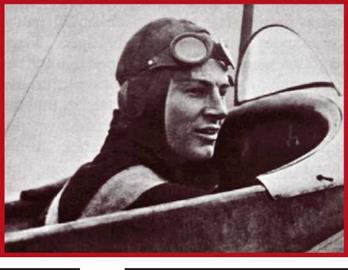 |
The War Ministry and the Central Inspectorate opposed von Moltke’s plans. Both bodies felt aviation was too new and weak to be afforded such a degree of inde – pendence. Regardless of this disagreement, from 1 October 1912 the German air arm began reforming along the lines proposed by von Moltke. Doberitz, Strasbourg, Metz and Darmstadt became the first Air Stations, or bases, staffed by 21 officers, 306 NCOs and privates. As reorganisation progressed, it became clear that the funds allocated were most inadequate. At the close of 1912 the Chancellor was asked for additional finance. The air arm was indirectly helped by the National Air Support Foundation led by Prince Heinrich of Prussia, which collected seven million marks. This mostly went to finance civil aeronautics and indigenous aeroplane designs which obliquely boosted the development of the air arm.
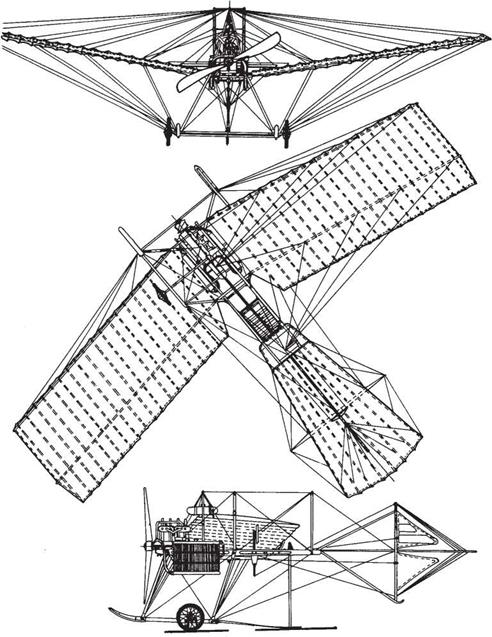
|
Despite resistance by some War Ministry circles, the General Staff resolved to begin replacing lighter-than-air apparatus with aeroplanes. Of rigid and semi-rigid construction, the outgoing machines had been used for tactical reconnaissance. The 15 rigid construction airships were henceforth to specialise in air strikes and strategic reconnaissance on behalf of the Supreme Command.
Air arm structures continued to evolve in 1913. The Military Aviation Inspectorate was created on 1 October. Oberst von Erhard was appointed Chief Inspector, commanding four Air Battalions each with three Squads, located as follows:
– No1 Air Battalion at Doberitz and Grossenheim
– No2 Air Battalion at Posen (now Poznan), Graudentz and Konigsberg (now Kaliningrad)
– No3 Air Battalion at Cologne, Hannover and Darmstadt
– No4 Air battalion at Strasbourg, Metz and Freiburg.
The semi autonomous Bavarian Army had a separate two Squad Bavarian Air Battalion.
In case of war, these airfields were to remain as main bases of the internal Squads. The reform foresaw the creation of 57 Field Air Squads and 46 Field Air Squads by 1916, and the creation of one air unit for each infantry division after eventual mobilisation. This appeared unrealistic due to tight deadlines and insufficient manufacturing capacity. Compelled to review timescales and organisational goals, the General Staff decided to concentrate on acquiring four Air Units, each with 12 six-aeroplane Air Squads, by 1 April 1914.
Since it was impossible for the air arm to secure a base for each Corps, aviation remained subordinate to the transport arm. Experience from the 1913 manoeuvres
|
I A Rumpler Taube with fictitious serial number ‘84’: disinformation for the enemy |
|
The real Taube No84 with a 100hp engine, strengthened landing gear and enlarged radiator |
also lent support for this status: air units still depended greatly on road and rail transport for mobility. Experience of incidents in combat conditions led the War Ministry to demand new and more reliable aircraft with stronger airframes. To this end, the Transport Army Experimental Section increased its establishment and changed its tasks, becoming the Directorate of Technical Transportation Testing. Combat pilot training also changed, becoming more intensive in the last months of peace to satisfy the growing need for pilots and observers.
The theory and practice of aerial reconnaissance for the needs of Army and Corps commands and staffs, as well as aerial artillery direction, marked significant advances. However both tasks were hampered by the lack of suitable communication. The lack of any onboard armament also meant limitations to aircraft use, the experiments in mounting machine guns and bomb racks on aeroplanes having enjoyed only modest success. Despite this, German political and military leaders assessed the place of aviation in a future conflict realistically, financing the programme for developing an air arm generously. Between 1906 and July 1914, military aviation was funded to the tune of 11,800,000 marks.
After the declaration of mobilisation on 1 August 1914, military aviation began war preparations in earnest. Comprising five aircraft and six airship batallions, with the latter supporting 33 field air detachments: 30 Prussian and three Bavarian. Ten of these were set aside to support the forces defending Strassbourg, Metz, Cologne, Posen (Poznan), Konigsberg (Kaliningrad) and Graudenz, and the major military centres of Beuen, Breslau (now Wroclaw) and Glogau.
The airship battalions comprised strength and discharged duties as follows:
– eight field airship units, each with an active and reserve kite balloon and a hydrogen production station;
– 15 castle airship units, each with a kite balloon and a total of a handful of shared spherical balloons, and
– 12 airships with 18 crews.
The air arm also had six reserve aeronautical units and five reserve field air battalions whose main duty was to replenish active units’ personnel and equipment.
Mobilisation took five days. The Armies were deployed and ready for action. A field air detachment was put at the disposal of each Army and Corps Staff. The supreme command had no aircraft or crews under its direct command. Field air units were subordinate to Army Staffs, and Castle Aeronautical units, being in larger industrial centres, served as a reserve.
After mobilisation, the German air arm comprised 254 pilots, 271 observers, and 246 combat ready aeroplanes. Half of the latter were Taube monoplanes, the rest being Albatros and Aviatik biplanes. Field air detachments had six aeroplanes each, and Castle Air Detachments: four each. The naval aviation unit managed to prepare 20 pilots for action. It had six aeroplanes, of which just half were serviceable: a strength completely inadequate for the provision of maritime patrol.
The first heavier than air machine was flown in Italy in 1908 by French aviation pioneer Leon Delagrange. He flew a series of demonstration flights over Milan, Rome and Turin. Beauty and emotion are close to the Italian spirit, and many Italian youths were soon enthusiastic about flying. Not a few of them were in uniform, though initially they set
|
I A pilot warming up the engine of an Albatros B prior to departing to a forward base near the border with France |
pursued their dream privately. Mario Calderara was one of Italy’s first pilots. His training included 23 lessons given by Wilbur Wright during his Italian visit in spring 1909.
At the time, military interest in aviation was purely theoretical. Since there was no objection to officers receiving flying lessons in their own time, using their own money, their attendance at the first flying school near Rome in 1910 surprised nobody. Flying soon became fashionable and six similar schools sprang al over Italy in a matter of months.
Tenente Savoia’s sensational 1910 flight captured the Italian imagination. He flew a Farman from Murmelon to the Rome suburb of Cintochelle, where on 2 August he took aloft Italian War Minister General Spinardi. Eleven days later, Tenente Vivaldi became the first Italian to die in an air crash while attempting to overfly Italy from Rome to Cit – tavecchia. Despite the tragedy, the year saw significant progress, 31 soldiers getting their wings, of whom 16: Italian wings (the rest had trained mainly in France and Germany).
Two military flying schools opened in 1911. Along with the paramilitary school at Cintochelle, they embarked on specialist and active military training programmes. Both were situated in the more industrialised Italian north. One was at Aviano near Udine, and the other: at Soma Lombardo. The larger school in Aviano opened its doors in April 1911 and had a mix of types: five Bleriot monoplanes, an Etrich Taube monoplane, a Nieuport monoplane, and three Farman biplanes.
The Italian military first used aeroplanes in manoeuvres during the annual exercises from 22 to 29 August 1911, led by Tenente Generale Polio. Capetane Carlo Piazza with a Bleriot, Capetane Ricardo Moisa with a Nieuport, Tenente Constantino Coagglia with a Savoia biplane, and Tenente Junio Guiglio Gavotti with an Etrich Taube flew for the Reds. Blue pilots were Tenentes Manlio Ginocchlio and Francisco Roberti with Bleriot monoplanes, Tenente Junio Hugo de Rossi with a Nieuport monoplane and Tenente Leonardo de Rada with a Farman biplane. The manoeuvres took place close to Monferrato, with the aeroplanes based at an improvised airfield near Novi, from where they flew a great many recce sorties. At the close of the manoeuvres, many military pilots took part in the September Air Races. Capetane Piazza and Tenente Giunio Ga- votti were awarded the Medaglia d’Oro for services to military aviation.
Italian military flyers had to show their skills in earnest all too soon. On 29 September 1911 their country started a war with Turkey in an attempt to increase its influence in North Africa at the expense of the crumbling Ottoman Empire. Military Council deliberations concluded that the cavalry was unsuited to difficult desert conditions. Accordingly, seven aeroplanes and 30 of the best trained aviators (including five pilots) were shipped to join the expeditionary force in Tripolitania, tasked with supplying reconnaissance.
Set up using Aviano Flying School aeroplanes, the First Aeroplane Flotiglia deployed near an old Jewish cemetery at Jafrah near Tarabulus (now Tripoli). Aeroplane reassembly began on 15 October, and several days hence a Nieuport, two Farmans,
|
I The Italian crew of a soft dirigible |
|
Wheeling a stowed Taube across the field airstrip near Tripoli |
two Etrich Taubes and two Bleriots were lined up on the improvised airfield, ready for testing. Difficult atmospheric conditions, high temperatures and sand storms hindered normal operation. However, heavy losses caused to the Italian infantry by Turkish cavalry at the Sharah Shatt Oasis compelled expeditionary force commanders to resort to using aeroplanes as the sole means of observing enemy movements. The first combat sortie was on 23 October 1911. At 0619hr Tenente Piazza departed for Asisia, 60km south of italian positions, in his Bleriot-XI. After more than an hour’s flying, he returned with valuable intelligence on Turkish forces and their Arab allies. Similar flights became routine in subsequent days, bringing invaluable help to the infantry.
On 28 October, Capetanes Piazza and Moiso observed artillery bombardment from the battle cruiser Sardegna from the air. This led to the idea of using aeroplanes to direct artillery fire. A system of communication was agreed with naval officers, coming into operation a week later.
On 1 November Tenente Junio Gavotti carried out history’s first aerial bombardment when he threw four hand grenades. The use of hand grenades against enemy infantry and cavalry was to become routine for Italian pilots in future sorties. Naturally, the effect of this was more psychological than anything else. Following one of these flights, the Turkish authorities accused the pilots of bombing a field hospital. Investigations led to legal disputes: the 1899 Hague Convention permitted aerial bombardment, but only from lighter than air apparatus. Aeroplanes were missing from the Convention for obvious reasons. Article 25 of the 1907 Hague Convention forbade aerial bombardment of undefended targets even where they were otherwise targeted by land forces, if it put civilian lives and property at risk.
Despite the successes of the young Italian air arm which had attained combat effectiveness rapidly, the situation of Italian land forces in Cyrenaica remained dif-
|
Taube pilots taking their seats |
ficult. Improvised airfields near Tobruk (now Tubruq) and Derna were inadequate for air support. This dictated the setting up of a second aerial Flotiglia near Benghazi. This included 29 men, including four pilots. The three aeroplanes (a Bleriot, a Farman, and an Asteria) and the 110 metre airstrip only became operational on 29 November. A few days earlier, on 24 November, Capetane Mioso directed artillery for the first time in genuine combat. His flight, and subsequent ones, met ever better organised opposition. Small arms fire, largely futile at 1000m at which aeroplanes flew, was joined by artillery weapons mounted on special carriages allowing them to aim at aerial targets. Tenente Giunio Roberti’s aeroplane was hit under such circumstances. The danger led to pilots’ seats being lined with thick sheet steel during the January lull in fighting.
Another result of combat experience was the fitting of mechanical bomb holders to aeroplanes. Also, on 24 January 1912, Capetane Piazza’s Bleriot was fitted with a still camera delivered from Italy. After this, he flew aerial photo reconnaissance sorties, and the unit he commanded took part in mapping the area between Tarabulus and Al Gharian. On 4 March 1912 Capetane Piazza jointly with Gavotti flew the first night reconnaissance sortie, and carried out the first night bombardment. The conflict also took aviation’s first war victim, with the death of pilot Pietro Manzini on 12 August 1912. Other tasks of the Italian air arm included dropping propaganda leaflets behind enemy lines.
Two groups of volunteers from the Royal Italian Club led by its President Carlo Monti also arrived at Tobruk and Derna. Each had four men, and each was commanded by an officer. They flew their eight aeroplanes in a total of 150 sorties. One of these groups experimented with radio as a means of transmitting intelligence. One of the aeroplanes was fitted with a small radio set which received a signal sent from a warship.
|
A Bleriot is readied for the next reconnaissance flight at a field airstrip near Tripoli |
The experience of Italy’s nascent air arm in Libya proved to the world that, thought novel and consisting of fragile aeroplanes with weak engines, air power was sufficiently effective and mobile to play a significant role in the outcome of conflicts. Two main ways were developed for reconnoitring from the air: visual and photographic. Also tested was the delivery of strikes from the air (however symbolic, it became routine), directing artillery fire, and dropping propaganda behind enemy lines. In other words, many of the tasks performed by today’s air forces were first tried then.
Analysing the results of the war, Italian political and military leaders decided to boost combat aviation. Between April and October 1912, some 3,250,000 lire was spent on new aeroplanes and organisational development of this new form of service. Its emergence as a separate formation began after March 1912, when Colonel Vittorio de Montemozzolo recommended the formation of the Royal Italian Military Aviation Service on his return from an inspection in North Africa.
One of the first steps in the creation of this new service was the formation of a floatplane unit to patrol inland waters and the coast. Even before its creation, maritime aviation pioneer Capetane Alessandro Guidoni had begun testing aerial bombardment and aerial torpedo launching against shipping. His tests were successful and mark an important stage in the aeroplane’s conversion into an important and effective weapon.
Another novelty was the creation in 1912 of a Colonial Aviation Service. This further boosted fleet expansion, and by early 1913 Italian military aeroplanes numbered 50, and lighter than air apparatus: 14. Several flying schools were very active, including a floatplane school near Venice. The Army had 13 airfields, hosting the following units:
– Aviano: a flying school with Bleriots
– Bologna: Esquadriglia VIII
– Busto Arsisio: Esquadriglia V
– Cintochelle: Esquadriglias IV and XI
– Cuneo: Esquadriglia III
– Mirafiori: Esquadriglia I
– Padua: Esquadriglia VII
– Piacenza: Esquadriglia XVI
– San Francesco: Esquadriglias IX and X
– Soma Lombardo: a flying school
– Taliedo: Esquadriglia VI
– Venaria Reale: Esquadriglia II.
Esquadriglia designations changed by mid 1913 with the adoption of Arabic numerals. Aerial reconnaissance and artillery direction tasks were successfully carried out during the September manoeuvres. The Reds had two Esquadriglias, each with 11 Bleriots and Savoia-Farmans, while the Blues also had two Esquadriglias, each with ten Savoia-Farmans and Nieuport-Macchis.
By 1914 Italian army aviation comprised 13 Esquadriglias and two flying schools based on 14 airfields. Italy declared neutrality, but even though a direct threat by the Central Powers was not foreseen, aviators were training intensively for combat. Training involved mainly aerial reconnaissance skills, including those needed in strategic reconnaissance for the supreme command. The appearance of Giovanni Caproni’s trimotored aeroplanes led to theorising about their possible use as strategic bombers.
A Military Air Corps was founded on 7 January 1915. This had a headquarters and two commands (aeronautical and aviation) which controlled Dirigible Battalions, Esquadriglia Battalions, and Flying School Battalions. Italy entered the Great War on 24 May 1915. Its Air Corps comprised 15 Esquadriglias armed with 86 aeroplanes and staffed with 72 pilots. The Navy had 12 ground-based aeroplanes, some dirigibles which were not realistic weapons due to their limited performance, and 15 aeroplanes supported by a mother ship.
Russia is a country with a significant tradition in flying lighter than air apparatus. In 1904, Russians became the first to use kite balloons in combat. Several such balloons were taken to Port Arthur and took part in its defence. In the maritime theatre, tethered balloons supported the Vladivostok cruiser detachment. The possibility of using other flying machines continued to be studied after Russia’s defeat by Japan. Dirigibles were bought from France and Germany, and indigenously designed ones were put into production.
Official interest in heavier than air machines began in 1910 with the establishment of the Central Army School of Flying at Gatchino, near Sankt Petersburg. A similar school for the Navy opened a year later in Sebastopol. As early as 1909, monies from the military budget were allocated to the purchase of five Wright biplanes
|
I A Caproni Ca-33 three engined strategic bomber |
and several Bristol Boxkites. Russia has ten trained pilots who formed a special military reserve. At the opening of the Gatchino School, all airworthy aeroplanes were transferred there.
Even though early aeroplane building efforts brought no fruit, the enormous potential of Russian engineering thought brought some advances, particularly in military aeroplanes. In 1909 Porokhovchikov designed an aeroplane with an armoured cabin. Igor Sikorski and Yuriyev came up with many of the breakthroughs needed for the future helicopter. The state itself attempted to boost efforts at creating indigenous aeroplanes. Two aeroplane factories opened near the capital between 1907 and 1909, both with full financial support from the Russian Imperial Technical Society, which formed an Aviation Section in 1910.
Aviation rapidly gained popularity in Russia and enjoyed universal respect and attention, including advocacy from senior public figures. They not only sympathised, but also did all they could to ensure that the new challenge would be widely taken up by Russians. Grand Prince Aleksander Mikhailovich was among the foremost of these advocates. He used the two million roubles donated voluntarily by the public during the Russo-Japanese War for torpedo carrier construction, the training of Russian officers in France, and the purchase of several Bleriots and Voisins from France. Private donors also lent great financial support. The Grand Prince’s advocacy was reflected the place he occupied in the emerging structure of military aviation. He was appoint-
|
I Chief Pilot Abramovich with a student |
|
A Russian Bleriot at the Kubinka airfield near Moscow |
ed General Inspector of Aeronautics and Field Aviation. Until mid 1912, command over aviation rested with the War Ministry Technical Department. Thereafter it went to the Defence Council: the body responsible for overall Russian army and Naval combat readiness. An Aviation Division was formed on 30 July 1912 under the command of a Major General reporting directly to the General Staff. Its deputy commander was to be a suitably commissioned Senior Engineer. Organisation copied the French structure, and included a training department for field aviation, and a technical and field supply department.
The structure underwent more changes in 1913. Two bureaux were opened in the General Staff. One was the Chief Military Technical Administration, and the other, the Chief Administration of the General Staff. Russian military administration at the time was territorially divided. Each Governorship[11] had at least two Corps, and each of these had a six-aeroplane aviation Otryad. Similar Otryads were attached to fortress garrisons, special purpose commands, and commands tasked with operational and tactical reconnaissance and intelligence gathering. The idea behind this form of organisation was for a six-aeroplane (with two to six reserve aeroplanes) Otryad to be available to support to each Corps and each fortress garrison. The reorganisation was

|

planned to be complete by April 1914 which turned out a pipedream in view of limited finance.
In 1910 the Navy created its own aviation organisation. However, this faced the same technical resource problem as its Army equivalent. To resolve the issue, a Military Air Contest was organised at Gatchino in 1911. Gakkel’s biplane came first, but the authorities preferred to buy foreign aeroplanes. Army aviation bought French, German, British and American machines, and the Navy bought Curtises. With the exception of some Sikorski designs, Russian aircraft makers made only licenced copies of foreign designs.
The significant sums made available led to rapid development of the new air units. If Russian military aviation in 1910 comprised not more than 40 aeroplanes and three dirigibles, by 1911 these numbers had risen to 100 and nine respectively, reaching 150 modern and 100 older aeroplanes and 13 dirigibles by 1 April 1913. By August 1914, Russian military aviation, aeronautics, and aerostatics comprised some 263 aeroplanes, 15 dirigibles and 46 tethered spherical and kite balloons. Despite these impressive numbers, the air arm’s combat readiness was impacted by negative trends started during its very nascence. Relying on foreign made aeroplanes led to spares problems: the heterogenous fleet included no fewer than 16 tipes. The proportion of airships which were genuinely combat ready was minute, the mainstream being decidedly passe. Even though Russia had several aeroplane makers with great production capacities, their output was tiny compared with the volume of imports.
|
The Sikorski S-9 was exceptionally aerodynamic for its time |
|
THE KIEV DIRIGIBLE DESIGNED BY F F ANDERS IN 1911 |
The Tsar and government got around to recognising that the early withdrawal of support for indigenous designs was one reason behinds this state of affairs. In April 1914, the War Ministry authorised production of 326 aeroplanes, 13 dirigibles, and ten Ilya Muromets bombers. However, the time factor was working against them and things remained practically unchanged by the outbreak of the First World War.
In America, both the Army of the Potomac and Confederate forces had used tethered balloons in the 1861 -‘5 Civil War. As related earlier, the former force even had a seven-vessel Balloon Corps. Commanded by the energetic Thaddeus Lowe, this existed until 1863.
|
The Nieuport 4 was among the most popular aeroplanes in pre-War Russia |
Post-Civil War interest in aeronautics among US soldiers was weak or non-existent, ballooning being practised only as a sport. Things changed after the appointment of Gen Adolph Greely as US Liaison Forces Commander. An enthusiastic aeronaut, Greely succeeded in establishing aeronautical units in Liaison Corps. French balloons were purchased for these units, some of them seeing action in the 1898 Span – ish-American War. Indeed, one of them was hit and destroyed by Spanish fire, its loss increasing the general scepticism of aeronautics among US Army commanders. In fact, interest in all forms of flying took a blow after Samuel Langley’s failure to fly his aeroplane despite spending the then-lavish amount of 50,000 dollars. All too soon, the only remaining balloon unit was disbanded.
US soldiers failed to see much military advantage in the air even after the successes of the Wright brothers and other Amrerican and European pioneers. It took until 1 August 1907 for an Aeronautical Division to be formed within the Liaison Corps. Its first commander was Charles Chandler, with just two NCOs reporting to him. An airship was duly ordered, being commissioned the following year under the designation Army Airship No1.
Meanwhile, the American Aero Club was the subject of no less than presidential interest by Theodore Roosevelt. Despite the crash which injured Orville Wright and killed Lt Thomas Selfridge, the effect of the brothers’ biplanes was becoming such that the Army undertook to fund a replacement machine. Flown on 2 August 1909, this was taken on strength as Aeroplane No1. For the following two years, this remained America’s sole heavier-than-air military flying machine. The contract with the Wrights included the training of two officers in piloting skills. They were Lt Lamb and Lt Frederick Humphreys. However, even though they were the USA’s only pilots with wings, they soon had to return to their old cavalry jobs due to the lack of aeroplanes.
|
I One of the Wright Brothers’ workshops |
|
The Wright Model A was America’s first warplane. It had no armament, flew at 70km/h, and cost taxpayers 25,000 dollars |
In March 1911, Congress finally approved funds for aviation development. Another five airships were ordered for the Aeronautical Division. Its establishment also expanded, allowing a number of experiments on the military uses of aeroplanes. But here too, enterprising Glenn Curtis had stolen a march on the military. In late spring 1910 he flew a trial sortie armed with training bombs. The objective was to destroy a ‘ship’ marked by buoys with flags. With each pass, more and more bombs hit the target. In January 1911, the Wright brothers threw genuine bombs onto an improvised test ground near San Francisco. Meanwhile, Army officer Raleigh Suit had designed a specialised aeroplane bomb along with a basic aiming and release device. Despite successful trials, he failed to convince the military to buy his invention. Other testing involved endurance flying, aerial photography, and machine gunning ground targets from aeroplanes.
By November 1912 the Aeronautical Division had grown to nine Wright, Curtis and Burges aeroplanes, 14 Pilot officers, and 39 NCOs and troops. The decision was taken to move the unit South for the winter. The Wrights and their auxilliary personnel travelled to Augusta, Georgia, the Curtis went to North Island near San Diego, California: site of Curtis’s private flying school which began acting as the USA’s first military flying school.
The Mexican Civil War which broke out in 1911 began to spread. This troubled the US Government and in January 1913 the Aeronautical Division was detailed to support the Second US Army Division. It then moved to Texas City, Texas, where No1 Squadron was formed in March. The unit was not directly involved in combat
but the severe climate and terrain impacted its everyday tasks of flying, observing and patrolling the border. In June most equipment and personnel relocated to San Diego, leaving two aeroplanes, three pilots, and 26 NCOs and troops at Texas City. An inspection soon afterwards revealed a sorry state of affairs. Of the twenty aeroplanes purchased until then, nine were scrapped due to crashes or other damage. Eleven of the forty pilots had died in accidents. Of the 11 Wright and Curtis aeroplanes inspected, just five were pronounced fit for flying, and that only subject to thorough overhaul. The findings forced the grounding of the unit. Luckily, a new Cutis biplane with pusher propellers had just been successfully test-flown, and 17 were duly ordered.
|
|
THE CURTISS A.1 FLOATPLANE
|
I A Curtiss landing on the USS Pennsylvania |
|
Щ Just hours to go before this Curtiss is to depart from a specially rigged strip on the USS Birmingham |
Gradually aviation became a routine part of the US military scene. B 18 July 1914 the Liaison Corps Aviation Department had a personnel of 60 unarmed Pilot Lieutenants, and 260 NCOs and troops. These were unr Gen Scraven’s overall command. A senior liaison officer, he was known for his progressive views on the planning and conduct of warfare. By the end of the same year, the General proposed that US military aviation shld expand further, to reach 18 Squadrons with 12 aeroplane each. However, this idea had to wait until the USA entered the Great War.
The first aeroplane flight over Belgium took place on 26 May 1908. Pilot was Frenchman Leon Delagrange. The event inspired many young and not so young Belgians to fly. The following year Professor Emile Allard and Pierre de Gaterre succeeded in flying, whereas Julien de Lamin got his wings in France, at the Farman school. In
1910 he bought a Farman III and demonstrated it by flying from a field near Antwerp.
Flying from the same field on 7 July 1910, Lamin flew a historic flight with Belgian
War Minister General Helebaut on board. Strongly impressed, the General decided it was time to start training pilots for the Belgian Army. Enthused, Lamin offered to organise things. However, the General Staff turned down his offer, and did not approve a flying training curriculum it had commissioned from the Balloon Company CO. Instead, Belgian pilots were to train in French flying schools.
Two artillery officers, Lieutenants Baldouin de Montes d’Osterick and Alfred Sar – til, went first. Their example fired the dreams of young officers and the General Staff was flooded with applications for seconding to flying schools. This made Gen Hele – baut turn to Lamin to organise flying training, and the Ministry bought a Farman biplane for training purposes. Two artillery Lieutenants entered the new school: Eman – nuel Brone and Robert Denis, and another two were sent to France.
The first airfield was also established near Antwerp, comprising personnel quarters, maintenance workshops and spares and fuel storage facilities. This airfield became the birthplace of the Service Belgique d’Aviation, formally founded in spring
1911 with five pilots, two mechanics, a carpenter, and one aeroplane.
The opening of the Military Flying School on 5 May 1911 was an important step forward in the development of Belgian aviation. The event was marred by the tragic death of Lt Brone. The School’s specially purchased Farman which he was flying was also destroyed. Some months later, in September, the two surviving Farmans took part in the autumn manoeuvres near Antwerp. Several successful intelligence sorties were flown. By the year’s end, 13 Belgian officers had acquired wings. In November they also went through an observer course.
The following year began with a General Staff study on the options for aviation in a future war, and how it could influence infantry operations planning and execution. This coincided with the appointment of Gen Michel as War Minister. He brought new ideas, inluding ones with a bearing on aviation. The Flying School’s activity intensified.
Meanwhile, Belgian military engineers began trials of a new lightweight aircooled machine gun designed by American Col Isaac Lewis. After his design was rejected in the USA, he had come to Europe. Despite being underdeveloped, the Lewis Gun was a breakthrough in weapon design and was as usable in the air as it
|
THE FARMAN F20 AEROPLANE |
was on the ground. The first of four Farman F20 biplanes delivered to Belgium on 9 July 1912 had the first Lewis Gun mounted on it. Trials on 12 September were successful.
A Royal Decree of 16 April 1913 declared the formation of an Aviation Company and a Balloon Company. The Belgian Army comprised four Divisions, and the idea was for each to have its own Squadron in the future. After mobilisation, the Squadrons would grow to six, as would the Divisions.
In May 1913 some crews and aeroplanes took part in Army manoeuvres near Beverloo. There they astonished ionfantry officers with the speed and precision of data on adversary positions and force strengths. Mainstream vehicles were the Far – man F20s. Repeat orders had brought their number to 20 by July 1913. This was sufficient for the planned four Escadrilles to be formed. Each had four aeroplanes, eight pilots, and adequate surface transport to become an effective and mobile combat unit. The new organisational structure was tested in the August manoeuvres, which also confirmed the great effectiveness of aerial reconnaisance. After the manoeuvres, No1 Escadrille was assigned to No2 Division, and No2 Escadille, to No4 Division. The other two Escadrilles were judged insufficiently combat ready.
|
I Four Royal Belgian Air Force pilots and their Farman F20 |
|
|
After the declaration of mobilisation on 2 August 1914, the 38 military pilots were joined by eight civilian conscripts, some of whom brought their own aeroplanes. Of 22 serviceable aeroplanes, eight were sent to the front line to support the Belgian Army which was deploying in the border areas.
Even though the first decade of the 20th Century was a time of decline for Austria – Hungary, the country was still a Great Power. This prompted its political and military leaders to maintain a modern and well equipped army. Several Etrich Taubes were purchased in 1911, and four trained pilots returned from abroad, among them Gen Schleger. Austria-Hungary created her air arm in 1912, after French and German aerial might had grown significantly, and as the initial lessons from the use of aeroplanes in the Tripolitani – an War were becoming known. The exceptionally erudite Emil Uselak was chosen as Commanding officer. He began flying at 44, later becoming one of the Empire’s best known pilots. Uselak test-flew every new aeroplane type to enter Austro-Hungarian service. The Dual Kindgom had good aeroplanes of indigenous design, and its strategists had at once realised that the presence of an observer was compulsory for effectiveness.
By the start of the First World War, the Austro-Hungarian Army had eight aviation units with six aeroplanes each. The total of available aeroplanes, 70, was below the real requirement. In view of the nature of the relief and the war theatre, significant attention was paid to the design of a so-called ‘mountain aeroplane.’ The Loner biplane, which had a take-off run of just 30m, was eventually selected. The poor
|
I Austro-Hungarian pilots from the first graduation class of the Imperial Flying School at Wiener Neustadt pose before a Taube monoplane |
|
The Austro-Daimler engined Etrich Taube was one of the main Austro-Hungarian military aviation’s aircraft prior to the start of the Great War |
industrial base could not match growing Army demand and aviation needs were ever more dependent on Germany. This trend was to continue until the very end of the World War and the country’s collapse and disappearance.
The Imperial Japanese Army and navy created aviation units almost at the same time in 1912. However, interest in aeronautics and aviation in the Land of the Rising Sun dated back much earlier. The Army’s first balloons dated back to 1877. Balloons were successfully used in the 1904 Russo-Japanese War in the Siege of Port Artur. Six years later Capt Yoshitoshi Tokugawa was sent to a French flying school, with Capt Kumazo Nino going to a German one. Several aeroplanes were bought from abroad in 1911, more officers were sent to learn to fly, and later in the same year flying training began in Japan itself. The Army Transport Command formed an Air Battalion equipped with European aeroplanes and Japanese-made licenced copies.
|
I The Farman biplane which made the first flight over Japan in 1910 |
In June 1912 the Imperial Navy formed an Aviation Research Committee. A little while later six officers were sent to train in France and the USA. They were also tasked with researching the flying boat market. It was two of these pilots who later performed the first flight over Japanese territorial waters on 2 November 1912. The new flying boat base at Yokosuka saw a floatplane-equipped Farman and a Curtis take-off. Soon the other pioneer pilots returned from abroad. The first Navy Aviation Unit was formed, receiving in 1913 the mother-ship Wakamio Maru to transport and supply its flying boats.
As distinct from their Army colleagues, Japanese naval aviators saw some action. In September and October 1914 they flew active recce missions over the China Sea, sinking a German minelayer with bombs.
Another Far Eastern nation with aeronautical traditions began developing its aviation at the turn of the 20th Century. Russian pilot Aleksandr Kuzminskiy’s Ble – riot demonstration flights over Peking in 1910 were the impulse behind this. During the same year, enthusiasts Liu-Zun Ch’eng and Li-Pao Chung began building their own aeroplane. This was flown in April 1911 but crashed on its maiden flight due to engine failure. A General Staff decision of the same year set up China’s first Military Aviation Centre, with two Etrich Taubes being bought from Austria-Hungary for its needs.
The start of the Chinese Revolution provoked the return of many progressive and patriotically minded emigrants. One of them was the famous US sports aviator Feng Ru. He arrived in China with two aeroplanes of his own design, which he
|
I A Taube about to depart for China |
|
|
offered to the Army. This also marks the creation of China’s airforce. When Feng Ru died in an air crash in 1912, he received funeral honours befitting the founder of the nation’s air arm.
In 1913 the Peking government decided to create China’s first Aviation School in Nanking. China’s first qualified pilot, Zi-Yi Lee was appointed to head it. A dozen Caudron GIII and GIV were bought from France for its needs, and French instructors were invited to China. The same year maintenance workshops opened in Nanking and Kwanghe, marking the start of an aviation industry. Their first success was the building of a combat aeroplane with a machine gun in the nose, in 1914. Despite these successes, the development of Chinese aviation and aeronautics lagged behind that in Europe and Japan.
Spain and Portugal also created military aviation structures, albeit gradually. The foundations were laid in 1912. Personnel was mainly trained in France. Young Spanish pilots did get a whiff of gunpowder before the First World War (in which neither nation participated). Influenced by the French Army which activel yused aeroplanes in North Africa to observe warlords’ cavalry movements, the Spanish Supreme Command sent an aeroplane unit to Morocco. Their task was to fly recce missions and map the theatre of action. Commanding officer Capt Kindelan was an excellent pilot and officer with enviable theoretical knowledge in warfare (later he became Gen Franco’s head of aviation during the 1936 to 1939 Spanish Civil War). However, his period of command falls outside this volume’s scope.
The appearance of air arms touched nations like Australia (which armed its first Squadron with B. E.2as in 1913), Canada and South Africa. All of these dominions’ pioneer military pilots were trained in Britain in the run up to the Great War.
Without doubt, the major testing ground for trying the new type of weapon was the Balkans. This was where a number of pilots from Balkan nations and further afield
|
A Farman III at Biserda |
(Russia and Western Europe) got their first combat training. Turkey was not going to leave its European lands without a fight, and the clash between her and the newly emerged and rapidly developing nations was unavoidable. Part of the preparations for this clash included the creation of new air arms.
The dawn of aviation in the Kingdom of Roumania is linked with three names: Traian Vuia, Henri Coanda, and Aurel Vlaiku. As young students in the Bucharest Polytechnic in 1909, they were fired with the idea of flying. Aurel Vlaiku designed his first aeroplane in early 1910. The Vlaiku 1 was first flown early on 17 June 1910. This date is considered the start of Roumanian air arms: a valid judgement, since it was the military that first showed an interest in the flight. Funds set aside from the military budget, and help from another young man, Paris Ploytechnic graduate M. Cerkez, bought four aeroplanes from France: two Farman IIIs, a Wright B-Type, and a Santos – Dumont. Cerkez also won the right to licence-produce Farman IIIs. The machines were assigned to the Pilot School set up in the late spring of 1910. This first flying school on the Balkans had its airfield not far from Bucharest. Its first instructor was French pilot F. Guillaume. In summer 1910, M Cerkez and N. Filipescu completed training and were awarded wings.
War Ministry interest in aeroplanes did not end there. The first six pilots were sent to the Pilot School in spring 1911. They were Maj Makri, Capt Ionescu, Porucik Boiangiu, Porucik Protopopescu, Podporucik Nigrescu, and Podporucik Drutu. French instructor Viallardes headed the course, deputised by Cerkez; basic type flown was the Farman III.
By summer, three of the officers got their wings and training continued with the rest. Cerkez used the favourable circumstances to open a second Pilot School at Engi-
|
| A Farman III with auxiliary forewheels |
neering Corps. As the clash of arms on the Balkans drew nearer, it was renamed the Scoala Militara de Pilotaj. Pilots were trained on Bleriot XIs, Farman IVs and Farman IIIs. The first use of Roumania’s new military aviation came in the 1913 Second Balkan War.
In June 1913, Roumanian forces crossed the Bulgarian border and started hostilities against their recent First Balkan War ally. Both sides had military aviation, but the Bulgarian units were committed on the Western and South-Western approaches. The Roumanians had two Escadrilles.
Escadrille No1 was commanded by Capt Fotescu and had 11 Bleriot XIs, of which eight had 80hp engines, two had 50hp engines, and one had a 70hp engine. The other two aeroplanes were 70hp Renault-engined Farmans.
Escadrille No2 was commanded by Capt Bibascu and had roughly the same strength, apart from the Vlaiku 2 aeroplane, piloted by its designer.
Escadrille No1 reported to an Army Corps commanded by Gen Cutescu, with No2 remaining directly at Supreme Command disposal. The pilots flew recce missions, corrected artillery fire, and observed from the air. Porucik Protopescu and observer Porucik Avion were most active. Between 24 June and 13 July they flew 15 combat missions in their Bleriot XI, flying a total of 20 hours. On 13 July, Protopescu flew a recce mission near Sofia which was 180km distant from forward Roumanian positions.
After the war, convinced of the effectiveness of the new type of weapon, the Roumanian Ministry of War decided to build on what had been achieved and create an Aerial Corps. In June 1914 this had 44 aeroplanes, of which 12 were Farman MF7 and MF9s, 12 Caudron GIIIs, six Morane-Saulnier L-10s, eight Voisin IIIs, and six Bleriot XIs.
In Bulgaria, air navigation for military ends began with the formation of the First Airship Unit (Otdelenie) within the Railway Drujina by Order of the War Ministry dated 24 April 1906. Otdelenie strength was 37 men of whom two were officers; it had a 360 cubic metre spherical balloon imported from France. A second Godard balloon
|
I The Bleriot-XI was among the most numerous aeroplanes used in the Roumanian invasion in Bulgaria |
|
|
Number of Airplanes 300
France Britain Germany Russia Italy Belgium Austria – Roumania Hungary |
Graph 1: numbers of aeroplanes in service on the eve of the First World War of 640m2 was supplied in 1911, and the Sofia-1 balloon was manufactured using Russian materials in 1912. Otdelenie staff began growing: two more Bulgarian officers were sent to the Airship College in Russia, enabling an expansion of the Railway Drujina’s technical side in 1912.
Interest in air navigation and aviation grew after manoeuvres in France, and the successes of the Italian air arm in the Tripolitania War. The ultimate decision to create military aviation in Bulgaria was taken by the close of 1911. Funds were made
|
I A Bulgarian balloon preparing for launch in 1909 |
available for the purchase of five aircraft: a Bleriot XXI monoplane, a Voisin biplane, a Sommer biplane (all three from France), a Wright biplane (from Germany), and a Bristol biplane from Britain. Thirteen pilots and two mechanics went to the supplier countries and to Russia in April 1912.
The first flight by a Bulgarian pilot in Bulgaria took place on 13 August 1912 when Poruchik (Lieutenant) Simeon Petrov tested the newly arrived Bleriot XXI. The nascent air arm’s combat readiness was tested at the Shumen manoeuvres in early September 1912. These saw participation by the balloon unit with the Sofia-1 and by three pilots flying the combat-ready Bleriot XXI. These manoeuvres also saw the first reconnaissance sortie, flown at the infantry’s request.
General mobilisation was announced on 17 September 1912. Up to this moment, six Bulgarian pilots had received their wings and returned from training. The remaining seven were recalled later, some flying combat sorties as observers. An aeroplane Otdelenie was created only after the start of war, on 2 November 1912. It comprised three Pilot Officers, three aircraft, and had an overall strength of 62 men.
The Bulgarian army entered the war with a balloon unit equipped with two balloons and a Bleriot aeroplane. Supplies of more aeroplanes from Russia, France, Germany and England were studied.
The ascent of the Sofia-1 on 15 October is accepted as the start of active duty. The following morning the Otdelenie deployed south-eastwards near the village of Kemal, where it supported Bulgarian artillery. The Aeroplane Otdelenie received three new Albatros aircraft. On 16 October 1912, Poruchik Radul Milkov and Poruchik Prodan Tarakchiev flew the Bulgarian air arm’s first combat sortie. Their task was to reconnoitre Turkish positions near Odrin (Hadrianople), and army strength in the
|
Bulgarian trainee pilots at Etampes airfield near Paris |
|
Щ Simeon Petrov and his Bleriot XXI: Etampes, 5 June 1912 |
city itself. The pilot also threw two bombs without much effect. A second balloon sortie aimed to observe Turkish movements at tactical depth. This was the first instance in history where air navigation and aviation units were used jointly in actual combat on the same stretch of front.
The Bulgarian air arm continued to receive supplies. Nine Bleriots arrived from Russia. On 17 October 1912, Timofey Yefimov, one of Russia’s most experienced pilots, flew one of these. Formation of a Second Aeroplane Otdelenie started on 3 November in Corlu. The increased number of combat-ready aircraft also permitted a new method: simultaneous aerial reconnaissance and ground attack. Four aircraft flew such a sortie on 14 November over various objects of interest near Hadrianople and threw bombs. Departures were at small intervals, each aircraft then flying a different route to the target areas, which were close to each other.
Another historic flight took place on 17 November. An enemy target was photographed from the air for the first time in the Balkan War, and an international crew flew a combat sortie for the first time, pilot Giovanni Sabelli and observer Major Zlatarov throwing propaganda leaflets and two bombs in the vicinity of Hadrianople.
The Aeroplane Otdelenie remained at Kemal until the armistice, supporting Bulgarian and Servian infantry units. The Aeroplane Otdelenia now had 13 serviceable flying machines and flew 15 combat sorties in the nine days noted as having flying weather.
|
An observation balloon presented by Russia to Bulgaria near Hadrianople during 1912 |
|
I A Bulgarian Bleriot XXI being prepared for a combat sortie |
Once all 19 aircraft ordered had arrived, the Third Aeroplane Otdelenie was formed. The nascent Bulgarian air arm had a total of 13 trained pilots, of whom eight were foreign volunteers. The armistice saw organisational improvements at air navigation and aviation units. These resulted in the following organisation:
– the First Aeroplane Otdelenie (four aircraft and three pilots) based at Svilengrad airfield;
– the Second Aeroplane Otdelenie (four aircraft and four pilots) based at Corlu, Cerkezkoy and Kabakcakoy airfields;
– the Third Aeroplane Otdelenie (one aircraft, one pilot and two observers) based at the Urma airfield; and
– the Balloon Otdelenie (two balloon stations with a spherical balloon and a tethered balloon).
Bombing came to be accepted as part of combat, for the first time in armed conflict beginning to assume the features of a mainstream activity. This dictated test and training sorties which tried out specially designed Russian and Bulgarian air drop bombs. Conducted at the Svilengrad airfield, these involved almost all pilots, who gained much useful experience.
After the resumption of hostilities on 21 January 1913, the contribution of aviation increased. Analysis of aerial reconnaissance became part and parcel of the duties of Bul-
|
Air drop bombs being prepared for training at Svilengrad airfield |
garian army staff. By the second armistice of 1 April, which led to the London Peace Treaty of 17 May 1913, all Bulgarian air navigation and aviation units had seen action, flying 55 sorties. Nine sorties involved bombing, using either special air delivery bombs or standard issue hand grenades, and six sorties involved leaflet drops over enemy positions.
On 26 January 1913 the First Aeroplane Otdelenie flew a recce sortie involving all four serviceable aircraft: an Albatros, a Farman, a Voisin, and a Bleriot. This was the
|
|
second time this new method had been used in aviation history; aerial recconnais- sance would later become the task of specialised air force units. The dropping of bombs was a secondary task for the crews, again using both specialised bombs and standard issue hand grenades.
Another remarkable sortie took place on 15 March 1913. Second Aeroplane Otde – lenie pilot Ernest Burie, flying a Farman, flew recce both near Carigrad (Constantinople) , and overhead the Ottoman metropolis itself. Setting off on the return leg, Burie noted that he was being followed by a Turkish biplane. Probably this was one of the Doppel Taubes recently delivered to Turkey from Germany. Overhead C atalca the ene – my closed the gap to the Bulgarian aircraft, coming to within three kilometres. Convinced that continuing the pursuit was pointless, the Turkish pilot turned south and threw two bombs close to Bulgarian positions without visible effect. The Farman landed successfully at Cerkezkoy airfield after 2hr 20min in the air. Enemy aircraft had also been noted overhead the C atalca lines on 23 February and 9 March, but this was history’s first encounter between adversaries in the air. Naturally, it would be premature to contemplate dogfights. The machines were unarmed and insufficiently capable of this, and in any case the armistice postponed dogfighting until the First World War.
Bulgarian military aviation’s last sortie in the First Balkan War was by the international crew of Giovanni Sabelli and Penjo Popkrastev. Their objective was to recon-
|
| Poruchik Mankov in his Voisin |
|
I A Bulgarian dragon balloon being raised for artillery direction purposes: March 1913 |
noitre Turkish units in the Dardanelles area. Departing on 23 March 1913, they flew both over the Galipoli (Gelibolu) Peninsula, and over Asia Minor. This was the first aeroplane flight over two continents. In the course of the sortie two bombs were dropped: at Gelibolu and Lapsaki (Lapseki).11
Due to poor weather, the Balloon Otdelenie saw limited action. It was based in the Hadrianople area and conducted reconnaissance and artillery direction operations.
The Second Balkan War started on 16 June 1913. At its start Bulgarian aviation had eight serviceable aircraft, eight trained pilots, and two observers. Supporting action by the First, Third and Fifth Armies on Bulgaria’s western flanks, the Second Aeroplane Otdelenie, with four aircraft and four pilots was based at Slivnica airfield. The Third Aeroplane Otdelenie similarly supported the Second and Fourth Armies and was stationed at Syar (Seres) airfield.
The Second Aeroplane Otdelenie undertook four reconnaissance sorties, all flown by the most experienced Otdelenie pilot, Poruchik Simeon Petrov. It was during one of these sorties that the second encounter between adversary aircraft took place. Most likely this was the 2 July flight, when the Poruchik flew to Vranya (Vranje) and back, and met a Servian monoplane in the air. Servian sources substantially confirm a similar encounter.
The Third Aeroplane Otdelenie flew three sorties under exceptionally difficult conditions on the ground. The Otdelenie lost two of its aircraft, a Voisin and a Bleriot, mostly due to the shortage of fuel and lubricants needed for them to be ferried to another base. [12]
The Balloon Otdelenie was also deployed closer to combat areas. But though garrisoned near Slivnica,12 it did not see action.

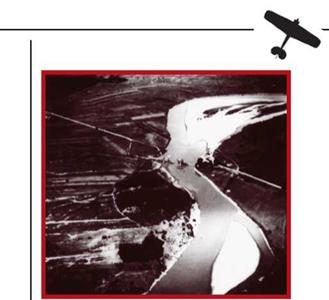 Bulgarian aviators fell on hard times after the nation’s defeat in the Second Balkan War. Yet, despite limited means, the desire for revenge gave added impetus to find a way out of the difficult situation. Seven more pilots were sent to train, and three Bleriots, two Aviatiks, and two kite balloons were ordered, but the outbreak of war halted delivery of all but two of the Bleriots. Due to limited finance, Bulgarian military aviation structures retained their Balkan Wars shape.
Bulgarian aviators fell on hard times after the nation’s defeat in the Second Balkan War. Yet, despite limited means, the desire for revenge gave added impetus to find a way out of the difficult situation. Seven more pilots were sent to train, and three Bleriots, two Aviatiks, and two kite balloons were ordered, but the outbreak of war halted delivery of all but two of the Bleriots. Due to limited finance, Bulgarian military aviation structures retained their Balkan Wars shape.
When mobilisation was declared on 10 September 1915, the Aeroplane Otdelenie comprised five aeroplanes (three Bleriots and two Albatros) and five trained pilots. The Balloon Otdelenie had a Bulgarian-made kite balloon and two trained Observer Officers.
The development of Greek aviation dates back to the publication in 1907 of a study by eminent lawyer Alfredos Atanasoulias, later reissued under the title The Progress of Aerial Flights. In spring 1908 came the country’s first attempted flight. Eccentric theatre producer Leonidas Arniotis who had studied aviation in France bought his own 30hp engined Bleriot and chose a grassy field near Tathios as suitable for his attempt. After a few unsuccessful attempts the monoplane flew, rising to some 10m before diving vertically. The pilot survived, but his aeroplane was beyond repair.
Greece’s first proper flight came a year later, when Russian aviator Utochkin flew a Farman for ten minutes near Paleos Faliros near Athens.
First Greek to fly over his homeland was Emanuil Argiropulos. During his studies in Germany this youth developed the desire to fly, going on to France to study piloting. Having got his wings, and acquired his own Nieuport, he arrived in Greece in January 1912. The aeroplane was assembled by the Ruf Barracks Engineering Unit troops. After a few days of preparations, on 8 February 1912 Argiropulos was enjoying the view from 300m, watched by huge crowds. An hour after landing, he was up again, this time carrying Greek Prime Minister Eleutherios Venizelos.
Six weeks after this memorable flight, Argiropulos organised and air race with Greece’s second pilot, Alexandros Karamanlakis, who had arrived with his own Bleri – ot. The date was set for 28 March 1912. However, the initiative fell through because
1 The village of Slivnica to the west of Sofia was close to the Servian border. Translator.
—;——————————————————————- >*;—————————————————————– —
Karamanlakis’ monoplane was wrecked due to a failure during the take-off run. Luckily, its pilot was unhurt and minded to continue aviating. He managed to repair his aeroplane and flew a series of impressive flights. At the conclusion of one of them, bad weather forced him to put down 200m off the Lygaea shore, where he drowned in rough seas. He was Greece’s first, and the world’s 193rd, aviation casualty.
In late 1911 the Greek Ministry of War announced a competition for officers wishing to train as pilots in France. Almost sixty applications were filed, but just three won: Senior Artillery Captain Dimitrios Kamberos, Senior Engineering Corps Lieutenant Mihail Mututus, and Cavalry Lieutenant Hristos Adamidis. A second three-man group was sent to train in April 1912: Sen Capt (Infantry) Lucas Papalucas, Sen Capt (Artillery) Markos Drakos, and Lt (Cavalry) Panutsos Notaras. Both groups trained at Henri Farman’s flying school at Etampes airfield near Paris.
Along with training its staff, the Greek War Ministry, also started negotiating to buy aeroplanes. The delegation included the National Defence Committee chairman. Perhaps influenced by their pilots’ schooling, the Greeks eventually bought two Henri Farman biplanes for 123,000 French francs. The machines were delivered in May. After they had been assembled, Sr Lt Dimitrios Kamberos was summoned back from France to test fly them. He did so between 13 and 15 May, crashing harmlessly in the process. On 15 May he reconnoitred for the ‘Invasion Force’ in manoeuvres which involved him until their end on 19 May.
The successful manoeuvres resulted in the formation of a Squadron under the command of the Engineering Corps Liaison Battalion in Larissa. The Squadron eventually boasted four 50hp-engined Henri Farmans, four qualified pilots, and fifty auxilliary staff. The unit was based at Greece’s first military airfield at the Trian field near Eleusina.
|
I The Greek Henri Farman before its reconnaissance sortie in support of the ‘invasion forces’ on 19 May 1912 |
|
I A float equipped Farman III: the first Greek floatplane was similar |
The creation of an army aviation unit soon led to the idea of a naval one. Sr Lt Kamberos championed this by fitting floats to a Henri Farman with the help of a group of army engineers and French mechanic Savot. The modified biplane first flew on 22 June 1912. The outbreak of the First Balkan War put paid to plans for a Greek naval air unit.
The nation’s first aviators went into action led by Engineering Corps Colonel Georgios Skoufos. The Squadron was at the direct disposal of the General Staff, which was also located at Larissa.
By the close of 1912, the Henri Farmans were obsolete and insufficiently effective. In particular, their inability to carry a second crew member was a major disadvantage. Apart from that, only one of them turned out to be fully serviceable. This was enough to prompt the order of 80hp-engined Maurice Farmans from France immediately the war broke out. These aeroplanes could carry an observer and had longer endurance.
The nascent Greek air arm first saw action in the beginning of First Balkan war at day time the infantry filed a request for the Skomia and Tsaritsani areas to be reconnoitred. Sr Lt Kamberos departed Larissa just after noon, later landing near Tirnavos to write his report to the High Command.
The same pilot flew his second sortie the next day, this time throwing several hand grenades over Turkish positions, and his aeroplane received numerous small arms hits. The following day recce flights were flown by the other Squadron pilots, who threw hand grenades ad-hoc. On 11 November, Sr Lt Kamberos penetrated enemy airspace by 60km, performing the first operational reconnaissance, by the standards of the day.
The Greek army swiftly moved north, beyond range of the old Farmans. The Squadron had to move to the new Kotsani airfield, along with the Army Staff.

 I The Maurice Farman biplane in prototype form: aeroplanes ordered by Greece had more powerful engines and significantly better performance
I The Maurice Farman biplane in prototype form: aeroplanes ordered by Greece had more powerful engines and significantly better performance
|
|
|
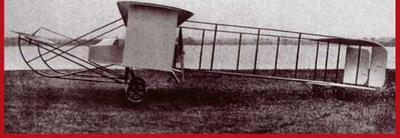
There Sr Lt Kamberos and Sr Lt Mututis tried a newly delivered Maurice Farman, using the opportunity to reconnoitre over Turkish positions, and ending in a forced landing due to engine failure.
This incident led to a reduction in recce flight frequency. At the same time, the adversary tried his hand at the game, a Turkish Henriot flying overhead Greek positions at the Battle of Antsion. The aeroplane was flown by a French mercenary. Greek advances put paid to such flights. The aeroplane was captured in fully serviceable condition, later gathering reconnaissance for its captors, flown by newly impressed Lt Emanuil Argiropoulos (who had volunteered along with his private Nieuport).
After the Greeks had attained their operational objectives in Macedonia, the Squadron was detailed to the Epirus front. The old Farmans turned out to be unsuitable for operation from the mountain airstrips. The three newly delivered Maurice Farmans were despatched from Athens to by ship, eventually reaching Preveza. There the unit retained its strength of four aeroplane, four Greek and one French pilot, a French mechanic, and 57 auxilliary personnel.
In late November the Squadron began flying from its new base. The first combat sortie was on 5 December 1912, involving recce of the Jannina region and the throwing of several hundred improvised bombs. Greek aviation saw action in Epirus until the capture of Jannina on 21 February 1913. On that day, Lt Adamidis landed his Maurice Farman on the Town Hall square, to the adulation of an enthusiastic crowd.
On 13 December 1912, Sr Lt Mututis, then based in Epirus, was detailed to Athens to help create a naval air unit. A month later, the first floatplane arrived from France: a 100hp Renault-engined Astra. Mututis arrived in Athens on board the requisitioned Varvaras vessel and made for the Midras naval base. After the Astra’s first
|
A Greek Henri Farman after redeployment to Preveza airfield |
flight on 12 January 1913, Navy Commander Admiral Kuduriotis decided to use his new weapon to reconnoitre Turkish shipping in the Dardanelles.
The mission was planned for 24 January 1913. The pilot, Sr Lt Mihail Mututis, and Observer, Naval Standard Bearer Aristidis Moragitinis, took their seats in the floatplane. The engine was warmed and the machine, with 115 litres of fuel and four hand grenades on board, accelerated for takeoff. The crew headed for the Turkish naval base at Nagara. Near Imbros they landed to refuel. They flew overhead their target at 1350m altitude, from which excellent weather allowed them to make a sketch map of the base and shipping in it. The hand grenades were thrown to no real effect, but the data supplied was exceptionally useful. The flight resonated in the world press, including the Turkish one, with unanimously high assessments. The pilots were lionised. The fascination was justified bearing in mind the mission’s complexity and the fact that the aeroplane was a constant target for enemy fire both on its outward and return legs.
Greek military aviation claimed its first victim. On 4 April 1913 Lt Argiropulos died when his captured Turkish Henriot crashed. Fate decreeed that the first Greek to fly over his homeland would also be the first one to die.
The Greek air arm saw no action against the Bulgarians in the Second Balkan War. In fact, it was to stagnate until 1916. As the prospects of Greece’s joining in the Great War increased, so did a process to improve aviation combat readiness. A pilot training centre opened at Sedes. After its first class had graduated, No 532 Reconnaissance and Bombing Squadron was formed, armed with Breguet 14s. This was the first unit to see action on the Macedonian front after Greece’s formal adherence to the Entente and its joining the War in 1917.
Servia endeavoured to keep pace with her neighbours. The process began with French aviator Simon’s demonstration flights in Belgrade in May 1909. In his Anzani,
|
Russian pilot Maslyennikov and his Farman at the Banica airfield near Belgrade |
he performed the first aeroplane flight over the Kingdom. Later the capital also witnessed flights by Russian pilots Maslennikov, Chermak, and Agafonov. Engineering Corps Kapitan Kosta Miletic was sent to Russia for training, and two balloons were bought from Germany: a 540 cu m free-flying spherical Kugelbalon, and a Parcival – Siegsfeld kite balloon. They were officially named the Srbija and the Bosna i Herzegovina at a ceremony. Due to various money problems, formation of the balloon Ceta took until the outbreak of the First Balkan War.
Despite the lack of money, in December 1911 the Ministry of War declared a competition for aviators. The decision to do so was influenced by the results of the previous year’s French Army manoeuvres in Picardy, where the aeroplane had shown its utility as a means of reconnaissance, and by the Tripolitanian War. Bulgarian and Greek efforts to create indigenous air arms and air potential undoubtedly also played a part. Limited funds forced only one candidate to be selected: Porucnik Borce Blagojevic. In the event, even he had to stay at home and await better times instead of travelling to France.
A second competition was announced in February 1912. This time, a group of three officers and three NCOs was formed. The Ministry of War contracted a loan of 30,000 dinars for their training and to purchase equipment and materials. On 29 April 1912 the group departed for Etampes, 60km from Paris. Three of them entered the Maurice Farman school and began flying two-seaters, while the other three went to fly single-seat Bleriots. As distinct from the Bulgars, the Servians sent no trainee engineers and mechanics, which was later seen to be a mistake.
Training took four months. Exams were sat and wings issued: for civil piloting. No military skills such as climbing beyond 1000m, observation, and dead-stick landings were studied. Trainees’ technical knowledge was also very vague. At the request of
|
I Preparing a Deperdussin for a demonstration flight: summer 1912, Banica airfield near Belgrade |
the two groups’ leaders, Iljic and Jugovic, the government made extra funds available. The 50,000 dinars were also earmarked for the purchase of three 80hp Gnome-engined Henri Farman biplanes, a 50hp Gnome engined Bleriot XI, and two twin seat Bleriot XI-2s with 70hp Gnome engines. Negotiations also began for the purchase of two 80hp Gnome-engined Deperdussins. In trials of one Farman, Servian aviators conducted their first aerial photography, albeit over a foreign land.
|
Щ Trainees at Eouis Bleriot’s flying school at Etampes near Paris. The first two frotn left are Porucnik Ilic and Porucnik Tomic. Two Bulgarians are also in the group |
|
Porucnik Jugovic, Narednik Petrovic, and Podnaredmk Novicic at the Farman pilots’ school at Etampes |
On 26 November 1912 the Servian airmen and their machines set off home by ship, headed for the First Balkan War which had raged for nearly two months by then. They arrived home on 2 December and began establishing an aviation unit near Nis. This consisted of a balloon Ceta and an aeroplane Eskadra. By late December the Servians had nine trained pilots, two mechanics, two observers, two balloons, and nine aeroplanes (including the Russian Duks brought by Agafonov).
The two R. E.Ps ordered by Turkey had arrived at Belgrade Station at the outbreak of the conflict and were requisitioned by the Servian authorities. Servian pilots expressed little liking for them in trials, condemning them unfit for action in mountainous or forested areas. The R. E.Ps were therefore not taken on strength.
The renewal of hostilities marked a new stage in Servian military aviation development. The successful use of aeroplanes over the Eastern front by Bulgarian and Russian pilots accelerated the newly formed air units’ incorporation into the infantry which was to be detailed to the Skodra (Shkodar) fortress, then besieged by the Montenegrin Army. Relocation was to be in two stages: first by railway to the newly taken
 port city of Salonica (Thessaloniki) , and then by ship to the vicinity of Ss kodra. The contingent comprised a single and a twin-seat Bleriot Xls, a Deper – dussin, and a Farman. the Servian pilots were joined by Frenchmen Godfroid and Kirstein, taking personnel numbers to 33. The remaining pilots and ground
port city of Salonica (Thessaloniki) , and then by ship to the vicinity of Ss kodra. The contingent comprised a single and a twin-seat Bleriot Xls, a Deper – dussin, and a Farman. the Servian pilots were joined by Frenchmen Godfroid and Kirstein, taking personnel numbers to 33. The remaining pilots and ground
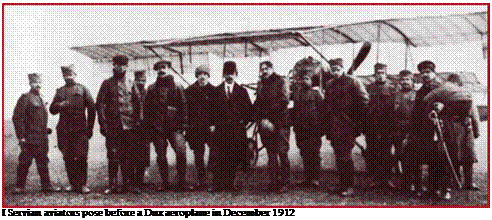 |
Changing the Gnome engine on a Dux staff remained at Mh.
|
Щ An R. E.P. aeroplane being delivered to Topolnica railway station near Nis for testing and possible combat duty |
The contingent set off on 19 February 1913, boarding the Greek steamer Marika on 27 February. On the way, the steamer was attacked by the Turkish cruiser Hamid – iye. The equipment was undamaged, but there were deaths among the personnel. At length, the battered flyers disembarked and made for the village of Barbalus near the fortress.
Servian pilots were keen to show their nation and fellow officers the capabilities of aviation in support of their own and the Montenegrin infantry. The aeroplanes were readied for flying by 7 March. Weather was warm for the season and clear, with the snow-covered jagged peaks ringing the airfield plainly visible. Some of these peaks, rising to over 800m above sea level, were on the direct approaches to the field. Cold winds blew down them, warning the aviators of tough times ahead.
The experienced French mercenaries who drew some 1000 dinars a month each, found a variety of reasons to refused sorties over Skodra. Despite having basic skills and a tenth of the pay, Servian flyers had the edge in morale. On 20 March, Aerial Command CO Miletic gave the order for trial flying to start. First to take his Farman aloft was Porucnik Jugovic, who returned 13 minutes later. He was followed by Porumik Stanko – vic who returned in his Bleriot after 25 minutes. At best, both pilots had climbed to not more than 900m: totally inadequate to escape fire from the besieged fortress. Third to fly was Narednik Mihajlo Petrovic. Finding a way to turn the powerful winds and limited area available to his advantage, he climbed to some 1200m. He then set for the fortress and flew over the Servian positions. On returning to base he again encountered a sud-
|
den downdraft and was not so lucky this time. He lost control of his fragile machine which dived, killing him. The Servians gave their first aviator victim.
On 22 March Porucnik Stankovic, followed by Frenchman Godfroid, reached Skodra. However, the first proper aerial reconnaissance of the fortress was on 29 March by Porucnik Stankovic and Narednik Tomic. Lasting 45 minutes and was conducted at a height of 2200m above sea level. A total of seven similar flights at infantry request were flown before the second armistice. Some sources claims that bombs were thrown during one such sortie but the adversary side does not corroborate this.
After the armistice, command of the Aeroplane Eskadra passed to Capt Milos Ilic, Capt Jovan Jugovic being given command of the Balloon Ceta. The contingent left Skodra on 6 April 1913 and returned to their Nis base 20 days later. As the threat of war with Bulgaria grew, the Supreme Command detailed Capt Stojkovic, Capt Ilic;, and Narednik Tomic; and two Bleriots to an improvised airstrip at the village of Vojnika near Kumanovo. The strip turned out small and surrounded by mountains. The personnel
 gathered gradually, reaching a strength of 37. Reserves included a Bleriot and a Deper – dussin which had been left pilotless after the French had gone home at the conclusion of the armistice.
gathered gradually, reaching a strength of 37. Reserves included a Bleriot and a Deper – dussin which had been left pilotless after the French had gone home at the conclusion of the armistice.
At the outbreak of hostilities along the Bulgaro – Servian line of demarcation, the unit came under Gen
. . . . . Pavel furicic’s command.
The Servian air arm’s first victim, Narednik Mihajlo Petrovic,
posing before his Farman III The General s army was ad-
vancing to Kustendil along the Cunino Brdo, Kriva Palanka, Kratovo line. Aviators conducted recce on behalf of the army command.
The Bulgars also had an air presence along the same front. During a sortie over Kriva Palanka, Narednik Tomic encountered an adversary in the air. The pilots waved at each other and set off to their respective airfields. One possible reason for such pleasant manners was the lack of any armament. Another was that some Bulgarian flyers had studied at Bleriot’s school at Etampes together with their Servian colleagues. The hour of the dogfight had yet to arrive…
Action lasted little over a month, during which time the Servians flew 21 observation and tactical recce sorties. Some requests for intelligence on the Kustendil front had to be denied since the area was barely within range and reaching it would have involved overflying mountain massifs. The Servians still harboured a healthy respect for strong winds at altitude! The unit had no trained observers and Capt Ilic proposed that two infantry officers be specially coached for the role. However, the conflict’s brevity pre-empted this initiative.
Meanwhle, Capt Jugovic’s Balloon Ceta had deployed near Crvena Reka near Pirot, and was preparing to use its sole surviving Russian tethered balloon for observation. Personnel numbered 45, and a field near Jamin Rid was selected as suitable. The Ceta entered action on 15 June 1913, marking its first success a week later near Nesk – ova Visa. On 25 July the unit finished its duties and returned to Nis.
The Kingdom of Servia left the Balkan Wars a victor with an almost doubled land area, but its economy was in a sad state. A new danger loomed all too soon, this time from the north. Time, and most of all money, did not allow for any significant change in the aeronautical command. Its personnel remained the same as did the number of aeroplanes, yet the lack of spares told on combat readiness. After mobilisation on 25 July, it took the Eskadra seven days to assemble, the Ceta taking 20 days. France was approached for aid in the shape of a dozen aeroplanes with pilots and technicians, but pressure on the French in the early weeks of war put such help beyond the realm of the possible. Servian aviators were to be left to their own devices for the first nine months of the war.
Having been heavily defeated by the Italians and having lost a major tract of its North African territories, Turkey now faced a new challenge. The objective of the military alliance of Balkan nations were more than clear: to seize and share among themselves the collapsing Ottoman Empire’s European lands. Despite the financial exhaustion of the recent war with Italy, combat experience dictated the recognition of the aeroplane and balloon as important attack and defence weapons, and as facilitators of naval artillery effectiveness. In fact, the first Turkish aeronautical decisions were linked with the establishment of anti-air artillery units. One of these indeed saw action in the final stages of the defence of Tripoli. These were also the first air defence units to see action anywhere in the world.
By mid 1912, eight Turkish officers began flying trining in French schools, another four going to Britain. A flying school headed by infantry Major Cemal bey was also set up in the Constantinople suburb of Yesilkoy. Two twin-seat and one single-seat De – perdussins, a twin-seat Bleriot, four twin-seat and two single-seat R. E.Ps, two twin – seat Bristols, and two twin-seat Harlands were ordered for the school and for future combat. However, the contract for the Bristols fell through due to delayed delivery prior to the outbreak of the First Balkan War, whereas two of the R. E.Ps were captured by the Servians in transit as related above. A little before the outbreak of hostilities the trainees were summoned back from abroad. The eight who had been to France returned with wings, while the four who had gone to Britain had not completed their courses. To strengthen its air arm, the Turkish command hired three French and four German pilots, and three French and two German mechanics. Two of the Germans arrived in a DFW Mars which the Turkish authorities later purchased.
There was no time for training flights, save for two sorties around Constantinople by Lt Nuri, on which he reached 1500m. He was later awarded an illuminated address by the Military Inspectorate for his historic achievement.
On 9 October 1912 the Turkish Prime Minister declared a general mobilisation. Operational war plans called for six aeroplanes to be in active service under the command of the Chief Military Engineering Inspectorate. Three groups of two aeroplanes each were formed. One was to secure the Eastern Army, another: the Western Army, and the third: the Hadrianople Fortified Region. The sole kite balloon (750cu m) also went to Hadrianople where it failed to see action due to the lack of a gas station.
Capt Cemal’s group, equipped with two Harlands and with two German pilots, went to the Eastern Army. Capt Fesa, Lt Nuri and a French pilot went to the Western Army with twin-seat Bleriots and an R. E.P The third group failed to deploy due to the rapid Bulgar advance. Its CO, Capt Revfik, pilots, ground personnel and two aeroplanes remained at Yesilkoy airfield.
|
Щ The French R. E.P. was the Turkish forces’ first combat aeroplane. This is the one seat version, suitable for aerial reconnaissance |
The first reconnaissance request came from the Eastern Army command and called for intelligence of the Kirklareli region. However, low visibility and driving rain pre – cluded flying. The Turks sufered another defeat, and the aeroplane group joined the retreating columns. Prior to departing, it is likely that the personnel thoroughly torched set the two Harlands. (A telegram despatch by Bulgarian Lt Gen Radko Dimitriev claims they were captured but Turkish sources deny this.)
The Western Army group enjoyed more success. Personnel and equipment deployed at Selanik (now Thessaloniki). The aeroplanes based at a specially prepared forward airfield in Koprulu, from which they flew several recce sorties. The retreat soon forced the aeroplanes to relocate to Selanik. Additional observation and recce flights were performed by 10 November around Karafare. After the Greeks approached Selanik, the pilots decided to torch the aeroplanes and take refuge in the home of a local bey.[13] Later the British Consul arranged safe conduct for all the pilots, bar one who had been captured by Greek Andartes. The Turks were shipped to Constantinople, the Frenchman returning home.
The situation of the Hadrianople garrison was growing more and more critical. Cut off from their hinterland and surrounded by a well trained adversary enjoying high morale, its chances of standing fast were reducing by the day despite Turkish conviction that the fortifications were impregnable. Hadrianople Garrison CO Sukri pasa insisted on air support, mostly to direct artillery fire. In this, he wanted to follow the example set by the Bulgars in their actions against his garrison. The lack of a gas station had rendered the fortress’s sole Parcival-Siegsfeld balloon unusable, hence aviation remained the only hope.
All serviceable aeroplanes (two newly arrived DFW Mars, two Deperdussins, two Bristols, and four R. E.Ps) were assembled at the Flying School’s airfield at Yesilkoy.
|
Щ French R. E.P. and Deperdussin were assembled at the Flying School’s airfield at Yesilkoy |
>
|
I Hidroplan attempt flight over Mediterranean sea |
However, this was 210km from Hadrianople. Turkish pilots had insufficient endurance flying training, while the French ended their conacts for one reason or another, ultimately leaving Sukri pasa without air support. However, all was not forfeit. The opportunity was used to conduct for intensive flying training of pilots and observers. The more experienced among them, such as Capt Selim and Sr Lt Fethi, flew recce sorties above Bulgarian positions on the Cs atalca front. Meanwhile, a detachment of two Turks and two Germans was detailed to the Galipoli peninsula, charged with supplying reconnaissance to units counterattacking the Bulgars there. While in tranit by sea, the detachment encountered a storm and emerged with damaged equipment. The Germans them made their way back to Constantinople and returned home.
Hostilities resumed in early February, after an armistice. Though much reduced in strength, Turkish aviation showed commendable activity right from the start. One factor for this was the concentration of its forces in the most vulnerable sector, another being the intensive recent training. The defence of the Cs atalca lines was critical to
|
Щ A Turkish piloted R. E.P. about to depart for training flight |
the nation’s survival. It was entrusted to an elite command, reinforced by considerable numbers of German and French advisers. Right from the start, the Army Staff sent requests to aviators for intelligence on Bulgarian artillery positions. A Deperdussin piloted by Sr Lt Fethi accordingly departed, carrying General Staff Major Sadat as observer. The crew spotted the Bulgarian batteries from a height of 800m. The flight lasted 1hr 10min and was a constant small arms target for Bulgars and Turks alike. The same crew flew two further recce sorties, but despite warnings, Turkish soldiers continued shooting at their own aeroplane. Capt Fesa flew over the next few days, his observers including Maj Cemal and Capt Kenan.
On 22 February Fesa and Kemal flew a two-hour long recce mission near Silivri. The flight was most fraught, a Bulgarian division concertedly firing on the aeroplane and causing it plentiful superficial damage. However, the information supplied was of immense import to the success of the defensive operations. The positions of a deploying Bulgarian regiment and its supporting artillery were pinpointed with great accuracy. The Commander of the Tenth Corps awarded the pilot ten gold lira for his heroism.
On 22 March German pilot Mario Scherf flew along the Kumburgaz, Corlu, Cerkezkoy route, discovering Bulgarian preparations near Corlu. Two days later Sr Lt
|
I A Deperdussin ready for take off |
|
Щ The Deperdussin single seat trainer was among the most widely used Turkish army aeroplanes prior to the First World War |
Fethi flew recce near Karakoy along with Lt Col Enver bey, tenth Corps Chief of Staff. They reached the Black Sea coast and returned safely to base. Mari Scherf and Capt Kemal crossed the Sea of Marmora, flew over the C atalca lines, reached Hadrianople and returned safely after a four-hour flight. The sortie was also remarkable for the fact that Kemal bey threw several egg-shaped bombs over adversary positions near the village of Kavakca: the first such use of an aeroplane in Turkish history. On 29 March Scherf and his observer Capt Kemal flew recce near Karaorman.
After the second armistice Yesilkoy hosted just three serviceable aeroplanes: a Ble – riot, a DFW, and an R. E.P Despite efforts to buy new aircraft from Germany and France, the number was to remain unchanged until 13 July when Turkey renewed hostilities against Bulgaria. Flights were flown by pilots Fesa, Nuri, Selim, Fethi, and Fazil.
On 21 July Sr Lt Fethi overflew Hadrianople in a DFW Mars. The following day Turkish units retook the city. An order on 26 July detailed Capt fesa with a Bleriot to the Right Flank Army, where on 28 July he flew recce along with a General Staff officer. The nascent Turkish air armflew recce and partol sorties until mid September 1913, losing one aeroplane when Sr Lt Fethi crashed his Mars into the Merica river (he survived, being temporarily hospitalised in Constantinople).
As part of plans to improve military and national potential, a P9 non-rigid airship manufactured by the Parcival Luftfahrt Flugzeuge Gesellschaft company arrived in the metropolis. It had been purchased in April 1913, but the Austro-Hungarians refused to grant it passage and it had had to be transferred by sea via Con – stanca. The 2400cu m dirigible was 48m long and weighed 2000 kg. It had a 50hp engine, a crew of six, and offered a 1200m cruise at 41km/h. Along with it, some 40 kg of grenades were delivered for throwing from the gondola. On arrival of the important consignment, an Aeronautical Unit with five officers and 100 NCOs and troops was formed at the harbour. Two mechanics and the engineer/aeronaut Haxter arrived from Germany as advisers. An airship hangar was erected at Yesilkoy airfield. The first sailing was on 5 August, with Haxter, Capt Fevzi, Navy Lt Murat, Lt Sakir, and a German mechanic in the gondola. They rose to 200 or 300m and flew around Yesilkoy and Bakirkoy for 1hr12m. More training sorties were performed in the following few days.
The authorities also directed efforts at increasing the number of aeroplanes. For the purpose, a delegation led by Veli bey, head of the Flying School, toured Austria – Hungary, Germany and France. Two months later, in March 1914, 20 Moranes were ordered for the Army, along with 15 Nieuport flying boats for the Navy. Capt Marcus de Goys, a French officer personally recommended to the delegation by Gen Bernard, assumed command of the Flying School.
De Goys arrived in Turkey in May and was promoted to Major. A short time later, three newly manufactured training Bleriot Delfins arrived, and a strenuous programme
|
THE CURTISS AEROPLANE FROM 1912 |
|
I Pilot Fethi bey helps Sefket haneme, first Turkish woman to fly in an aeroplane, alight from his Deperdussin two seater on 30 October 1913 |
—————————————— >——————————————————
of training for officers began. Newly arrived French mechanics repaired old aeroplanes which had been given up as ready for scrapping, boosting the fleet to pre-War levels. De Goys turned out to be an excellent flying instructor and educator. He proposed that all aviators should wear a new uniform, and also that a commission should meet to formulate a programme for the development of a Turkish airforce. This new command was to have 35 aeroplanes for army support, and 15 for naval support. Another six Caudrons
|
I The Curtiss floatplane had a single 100hp engine driving tivin propellers |
|
Щ The Turkish General Staff hoped the Caudron III order would improve combat effectiveness significantly before the start of The First World War |
and three Farmans were ordered from France. These were expected to arrive within two months, but the outbreak of the First World War put paid to the plans. In reality, the Ottoman Empire had just nine aeroplanes, of which just four were suitable for aerial reconnaissance: three 60/70/80hp engined R. E.Ps, and a 70hp engined Deperdussin. The Navy had three flying boats: a Curtis and two Nieuports. This strenght was badly below par, and the Empire would soon pay a heavy price for it.
|
I Twenty one year old Richard Raymond-Baker: one of scores of young men volunteering for RFC service at the outbreak of the Great War. As this photograph was taken, he was not to know that he would be killed in 1918, entering aviation history as the last victim of the conflict’s most famous ace, Mannfred von Richthoffen |
>











